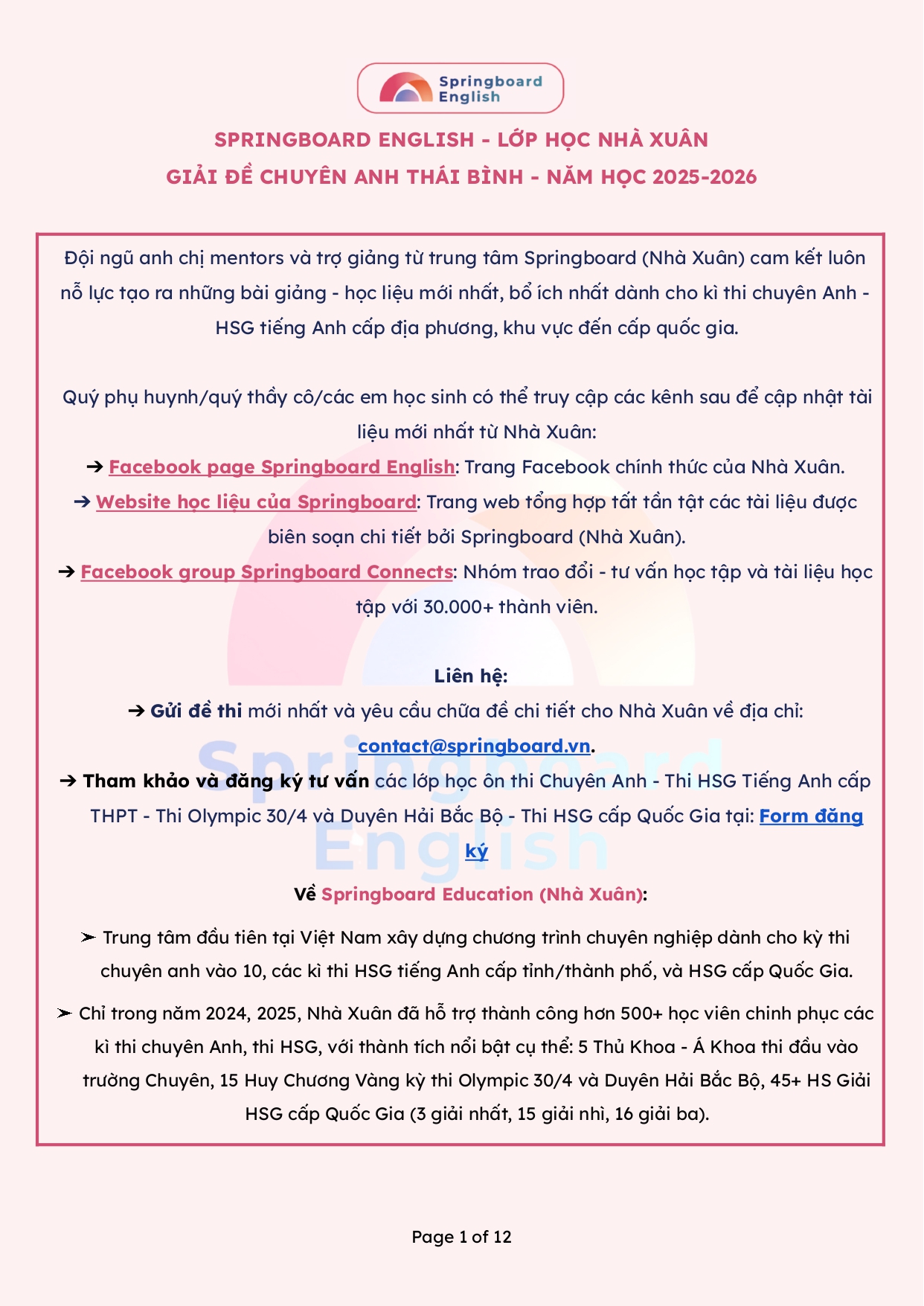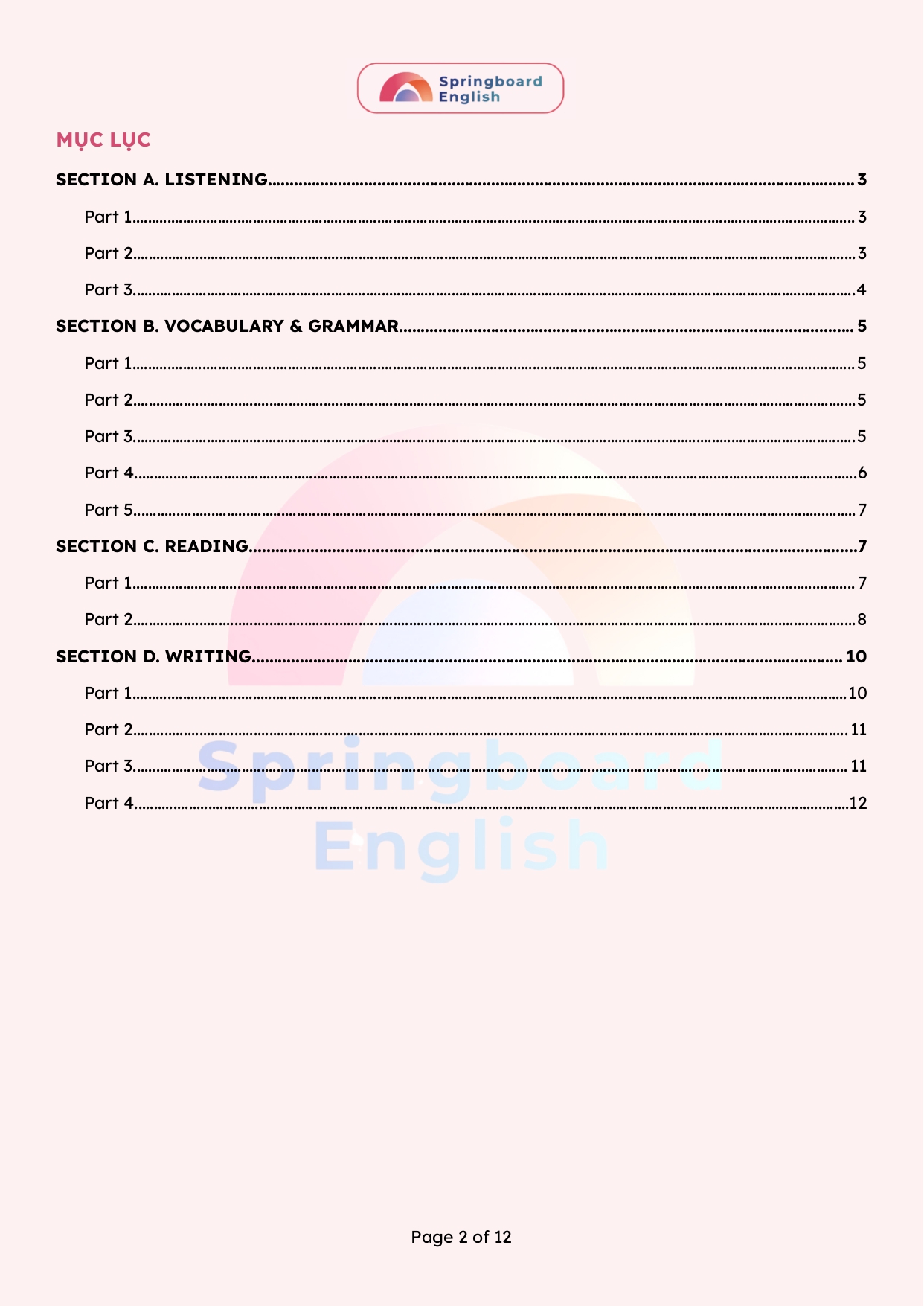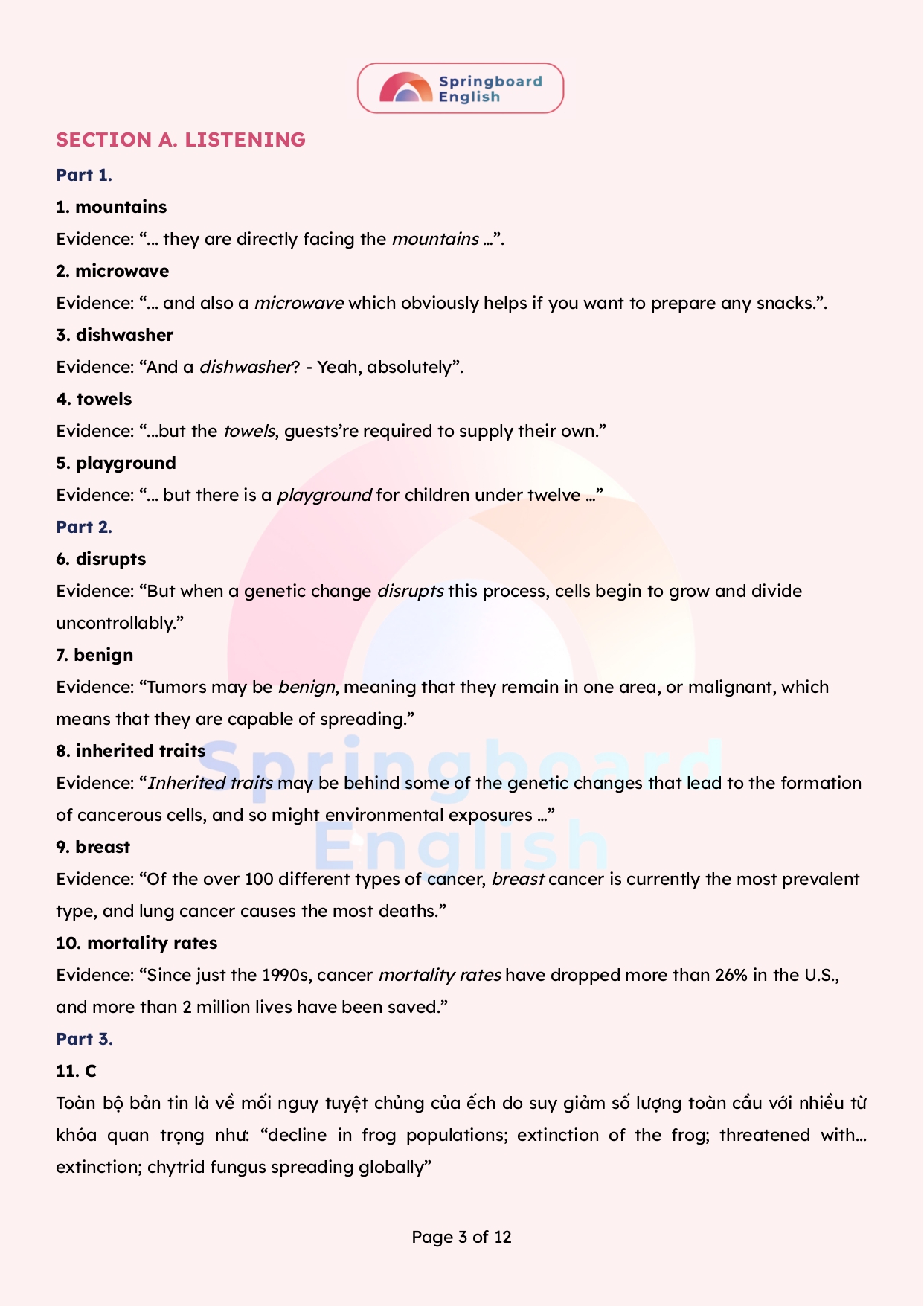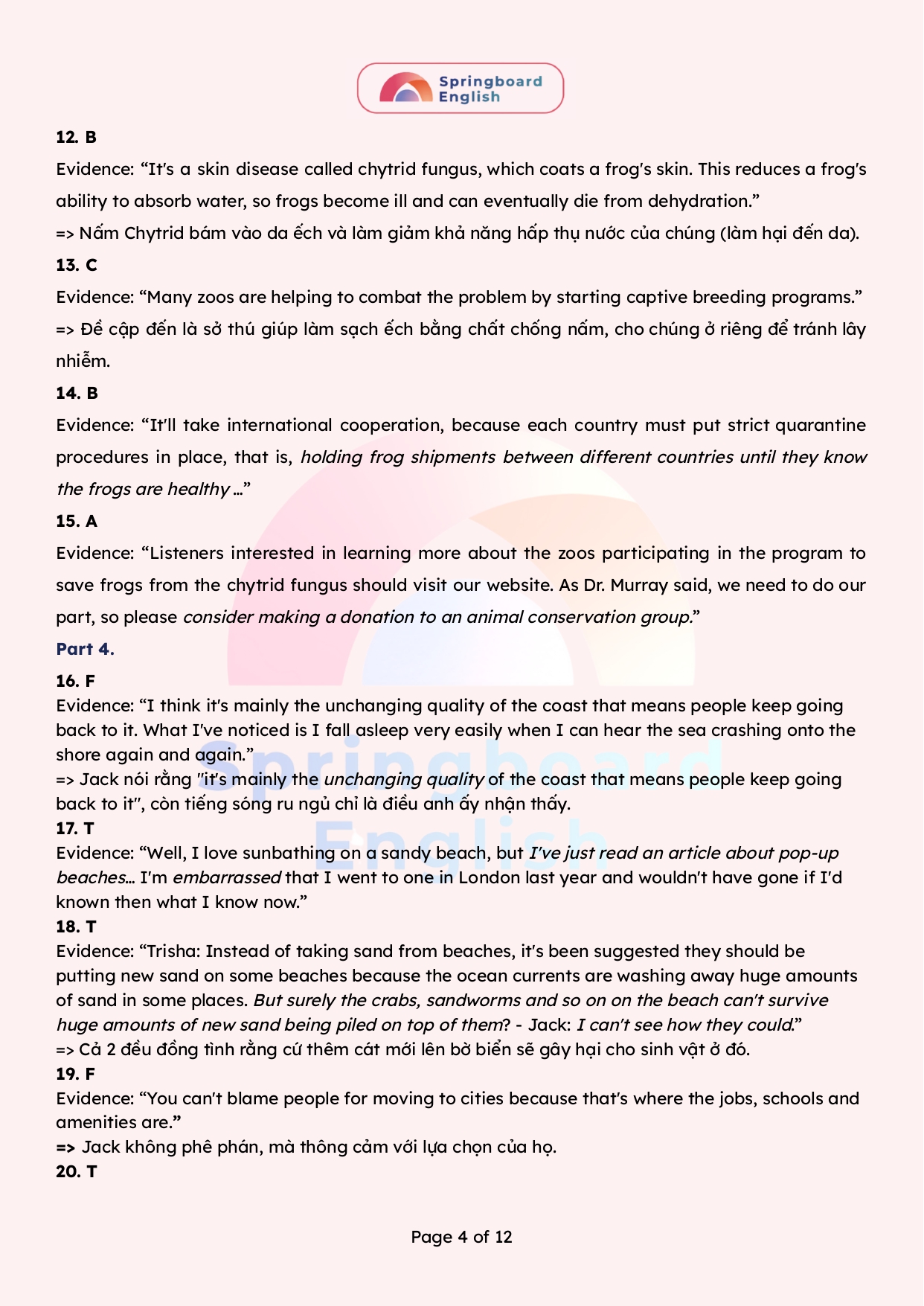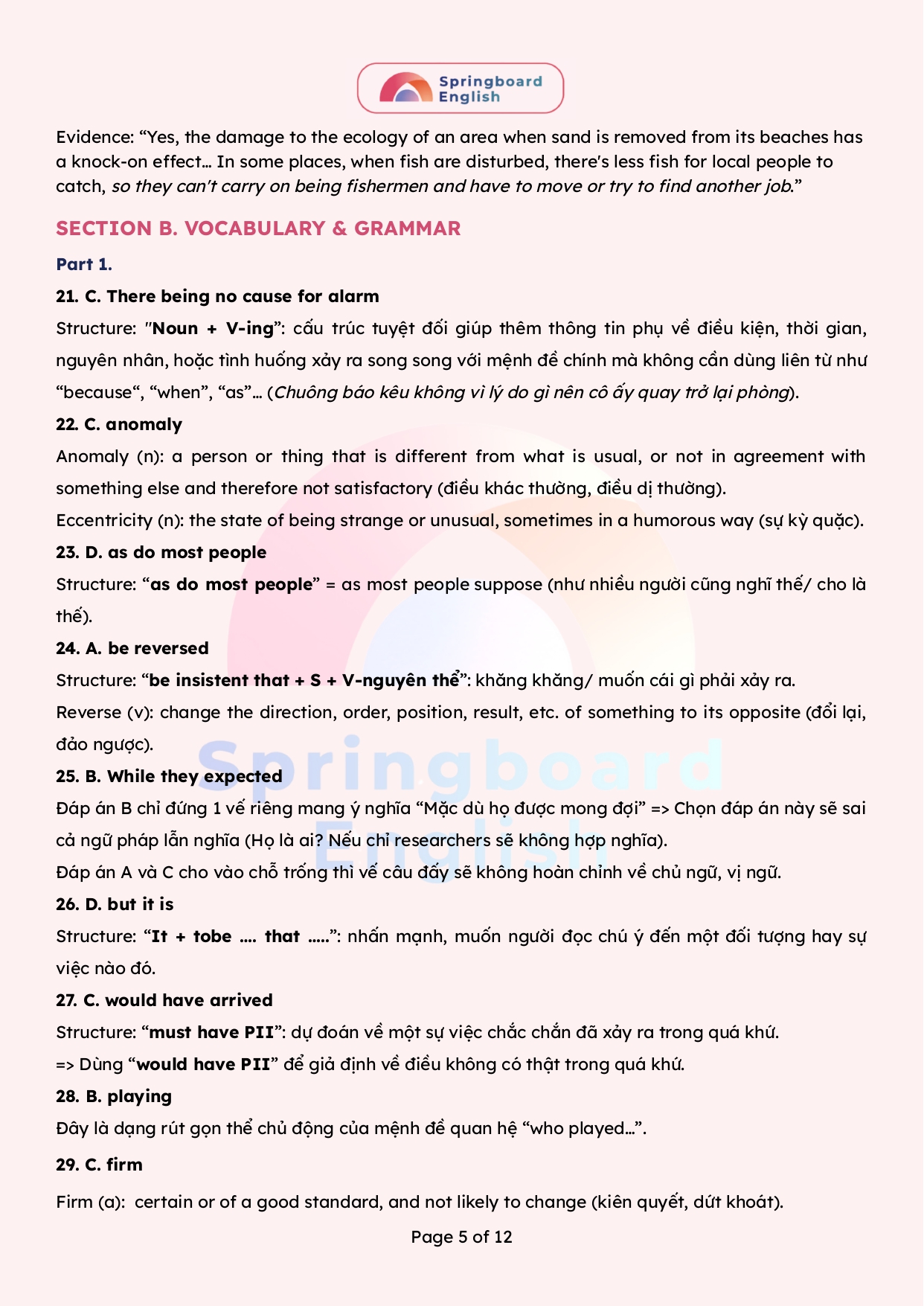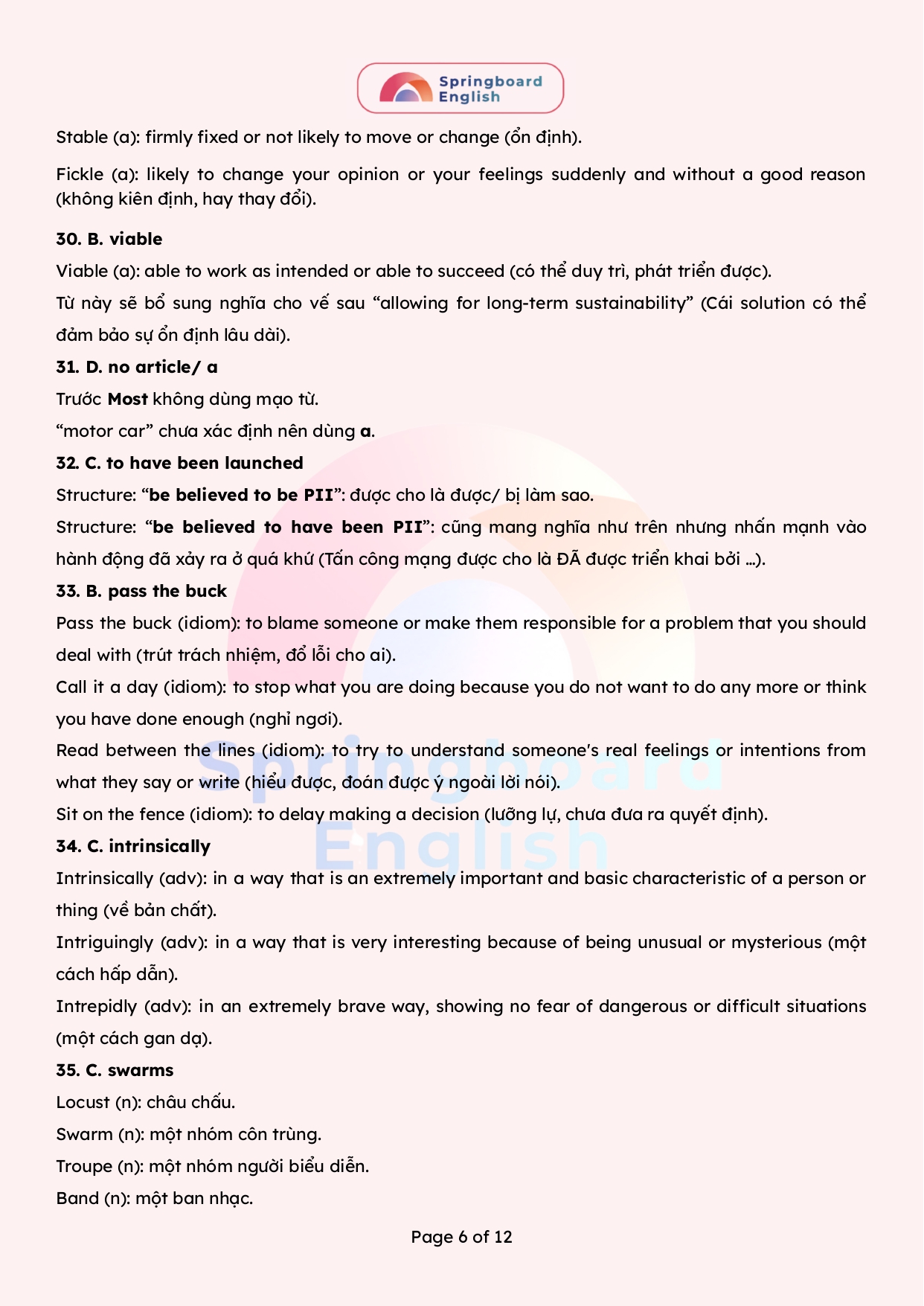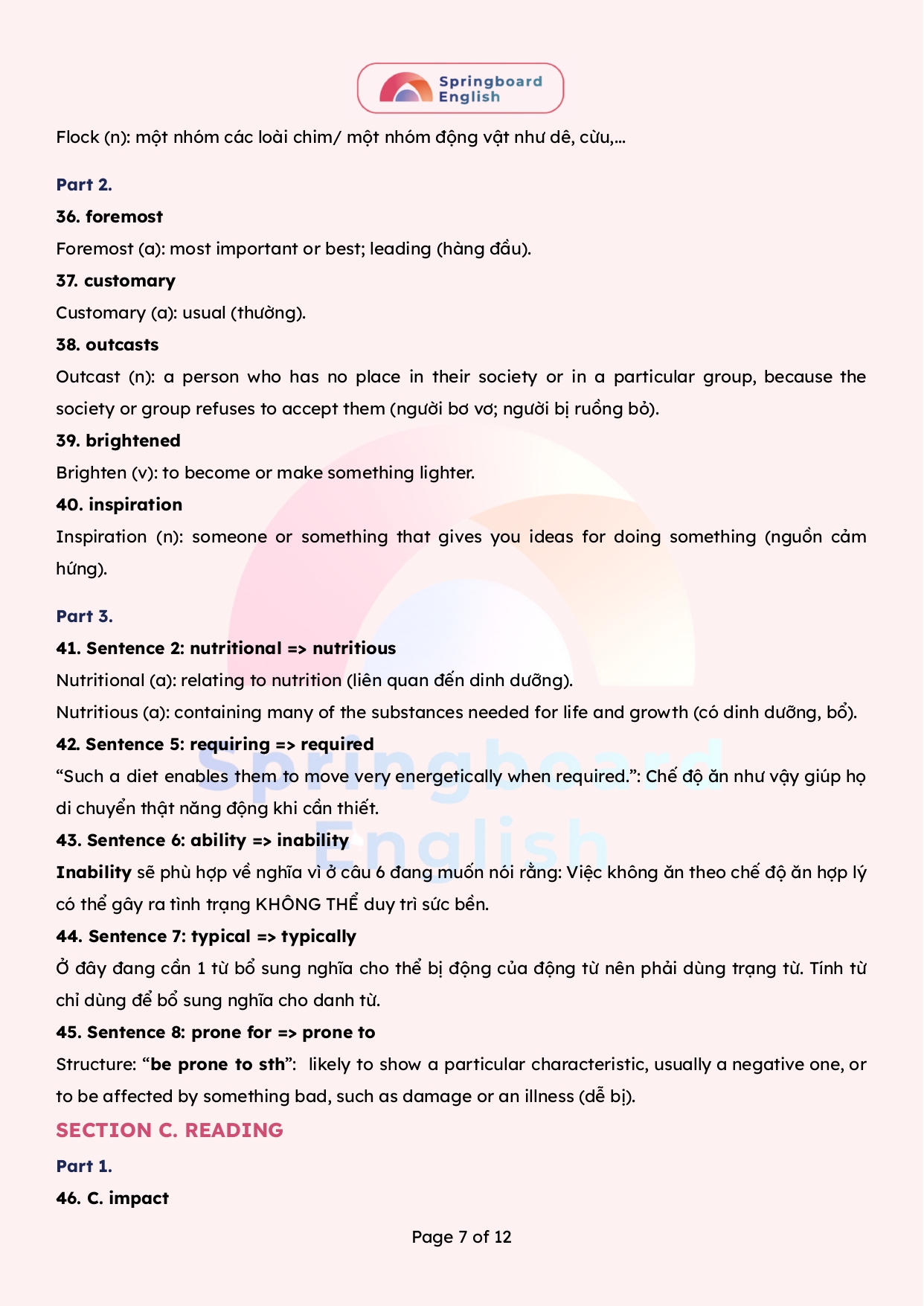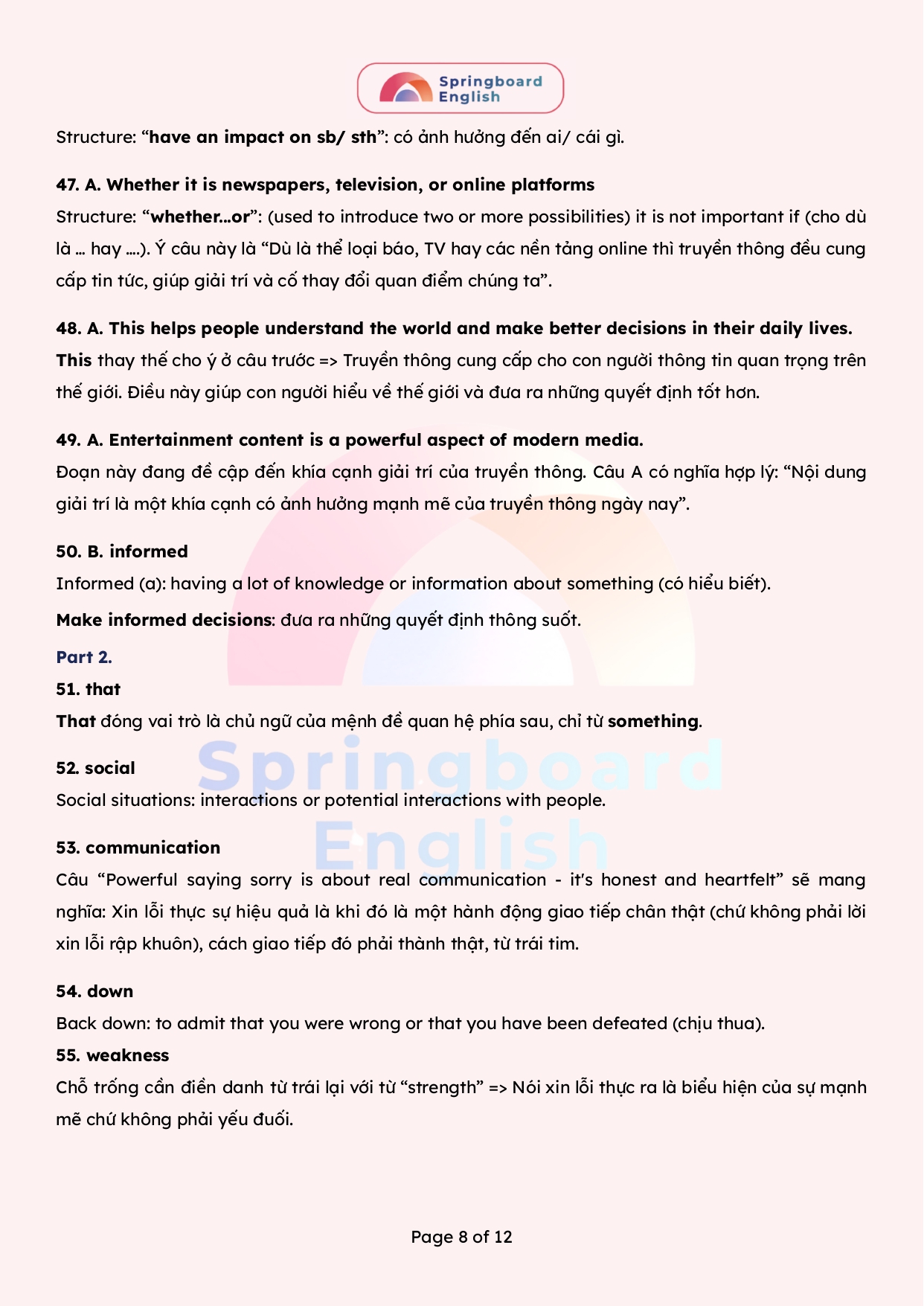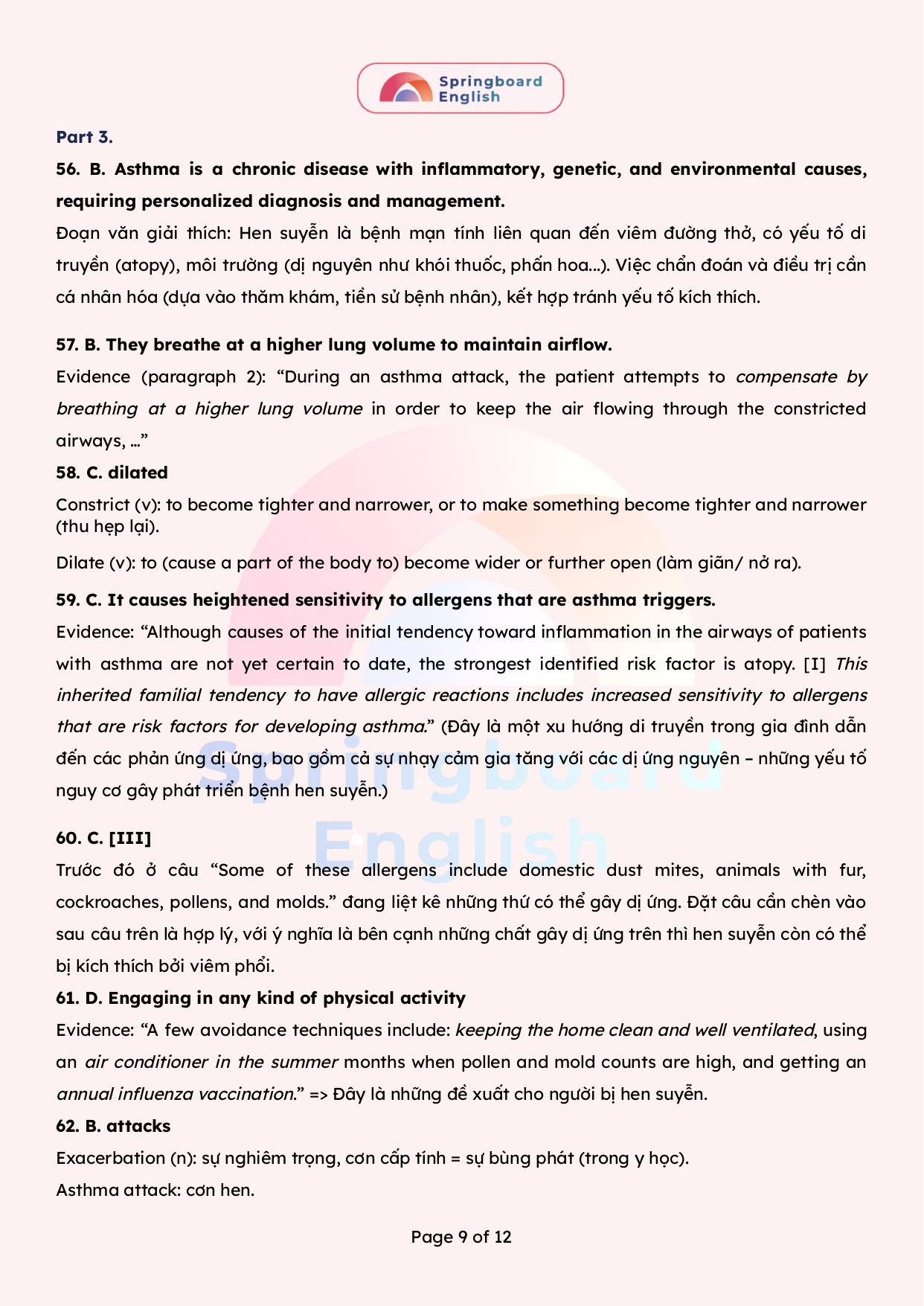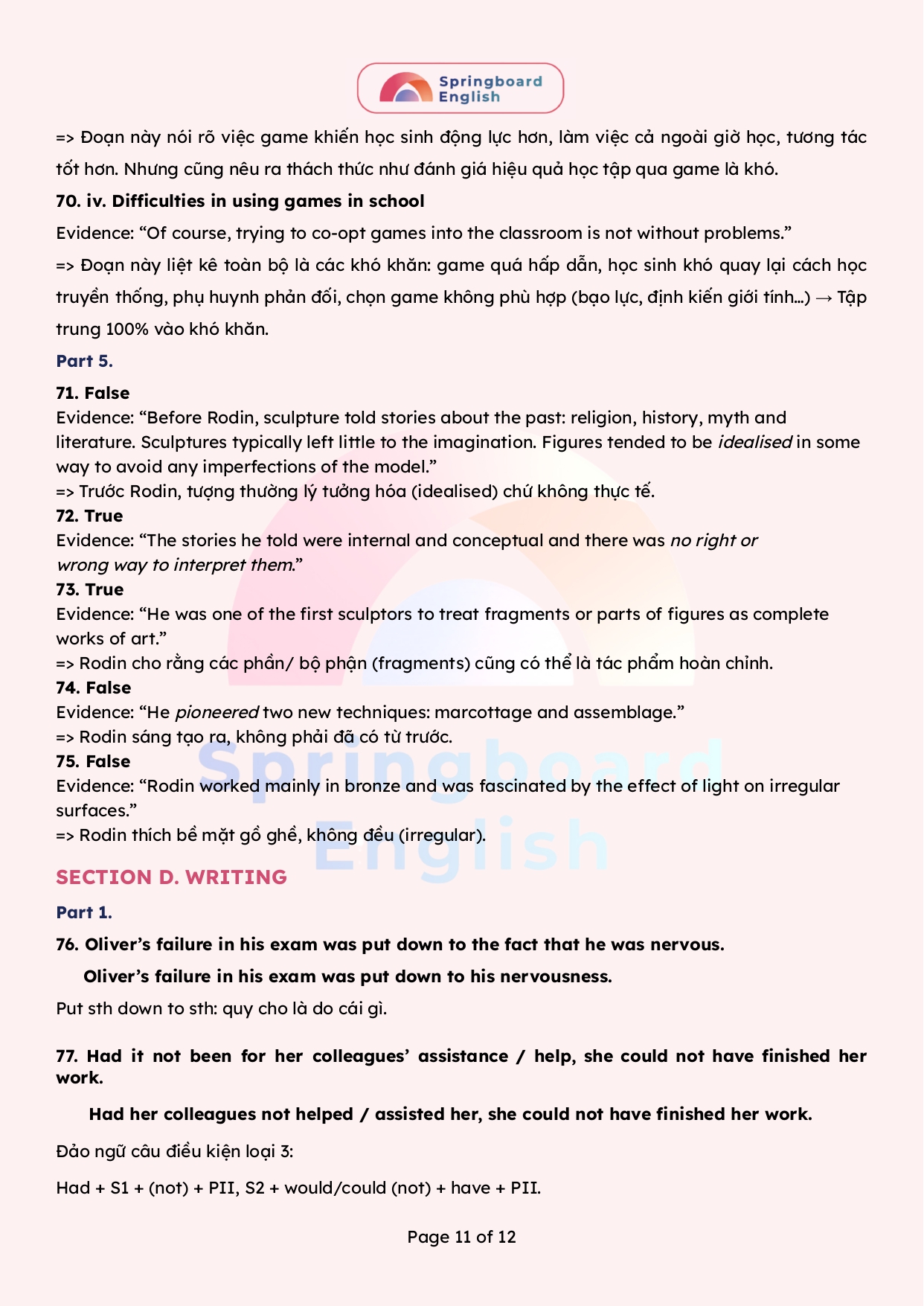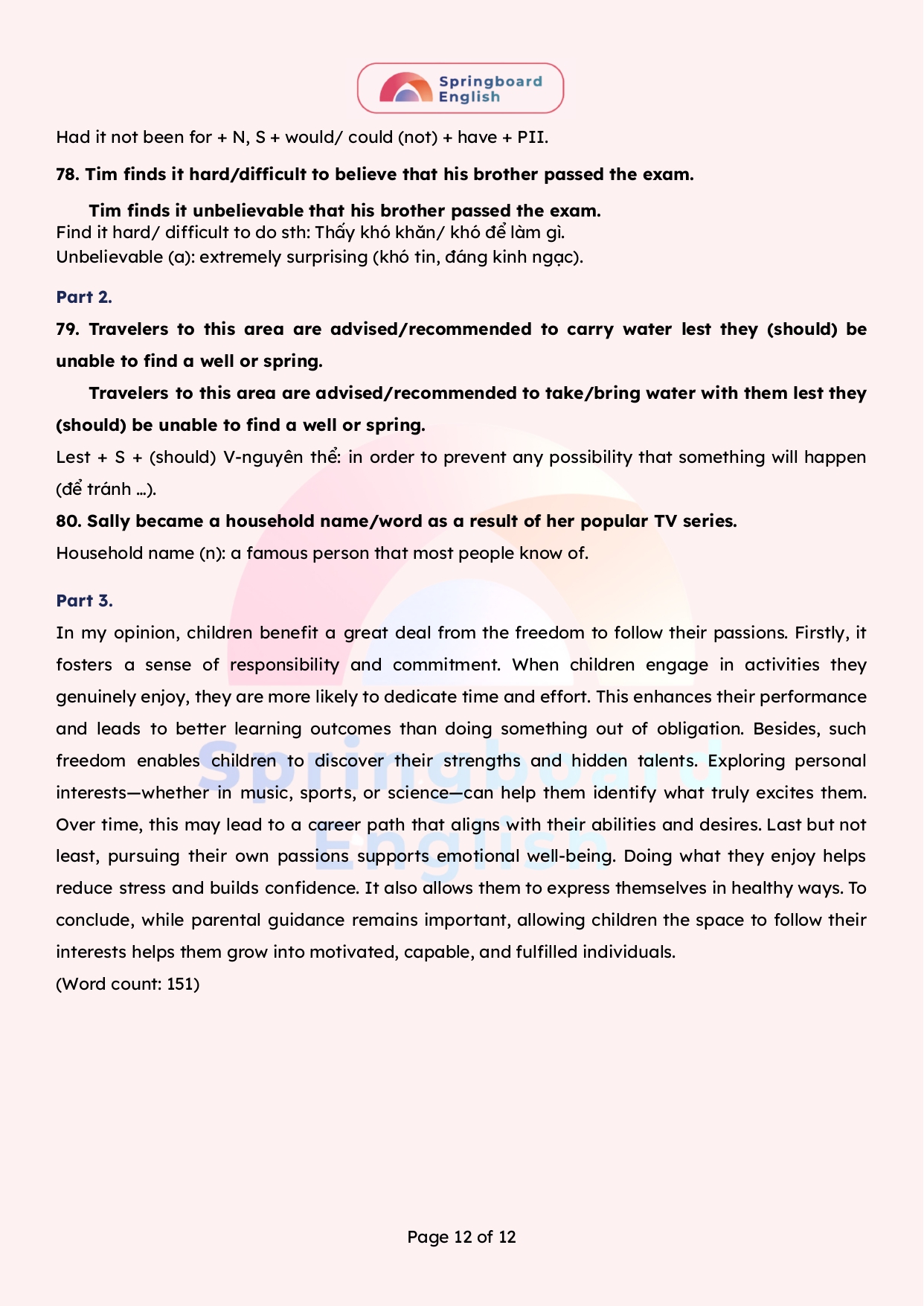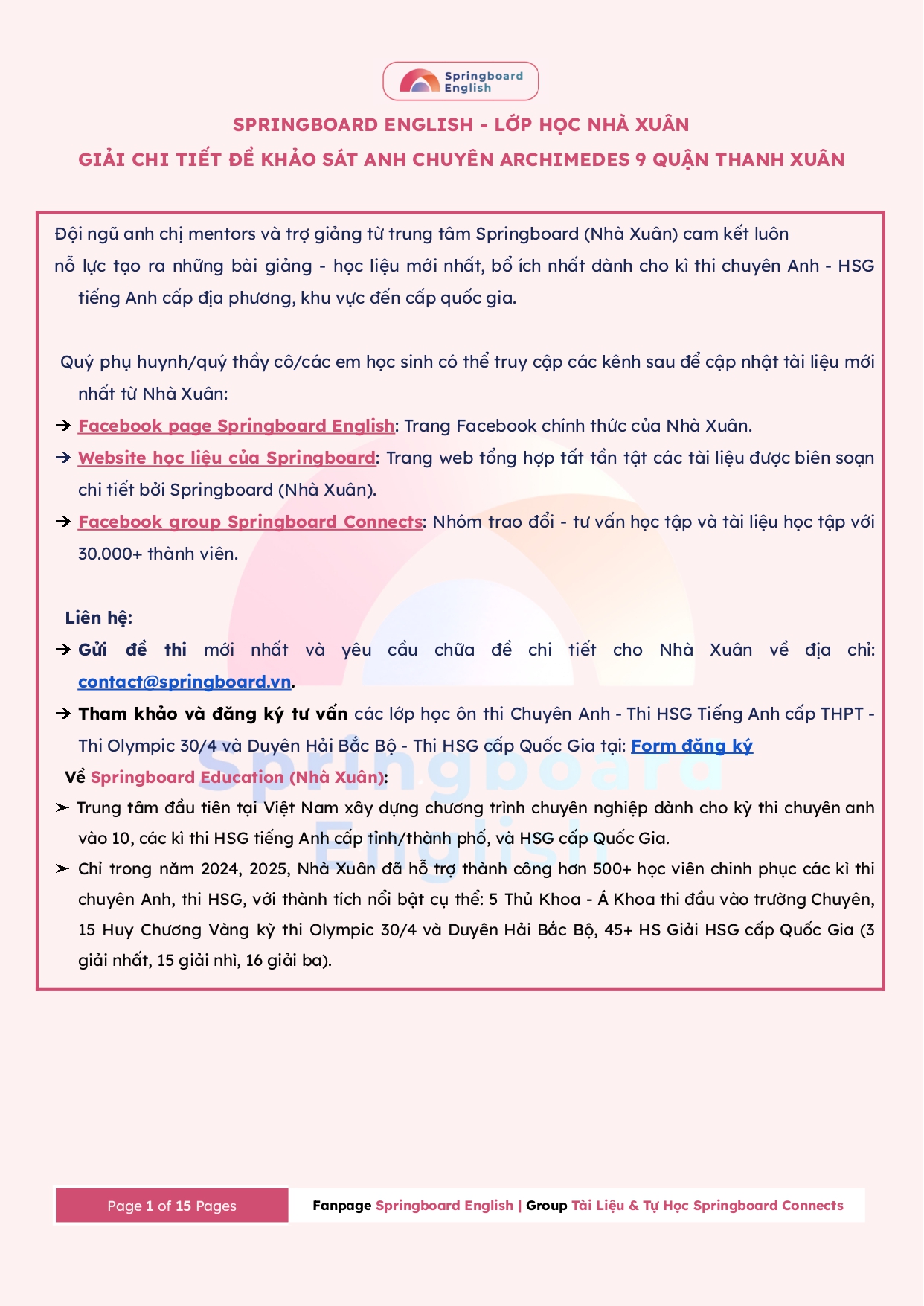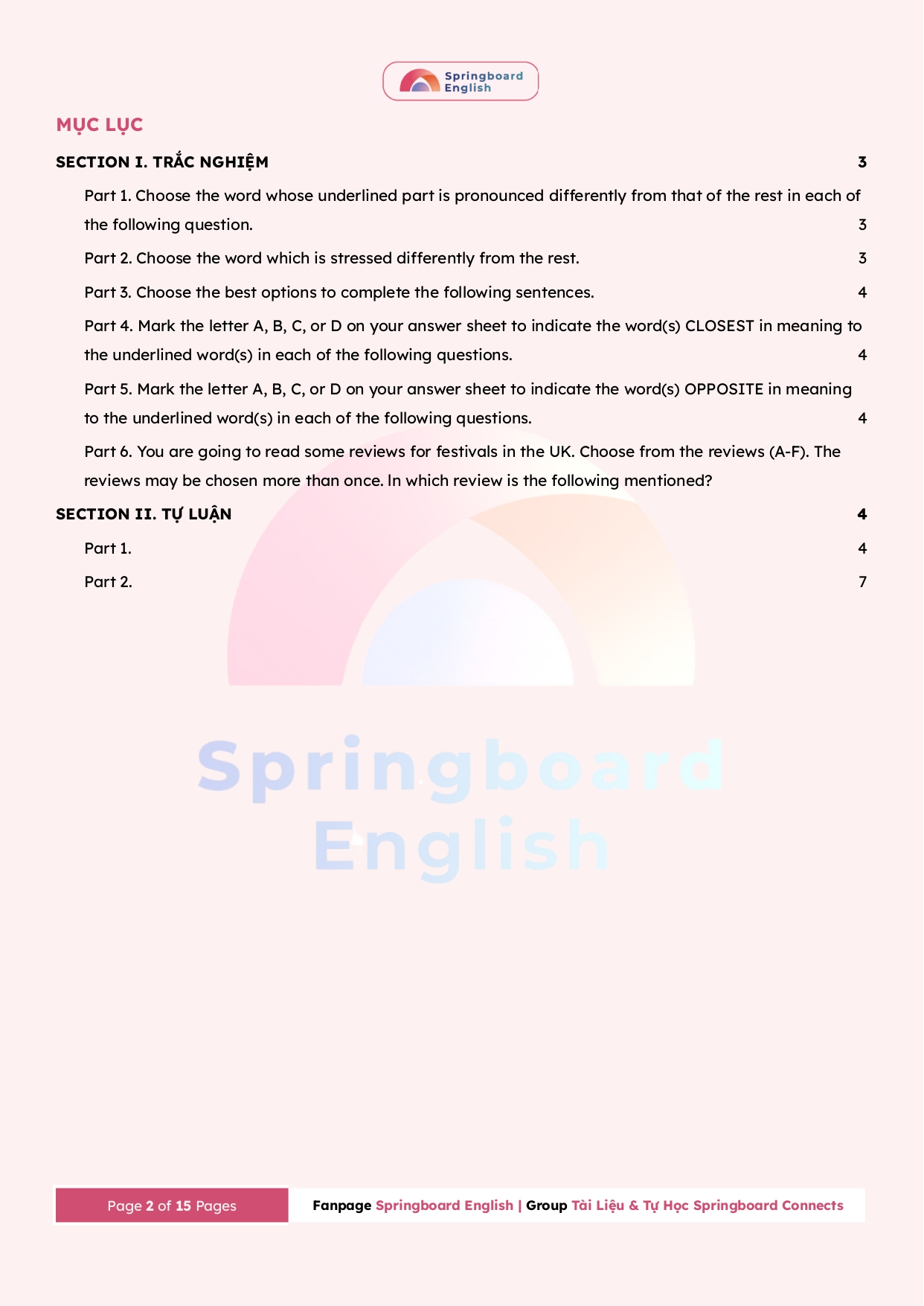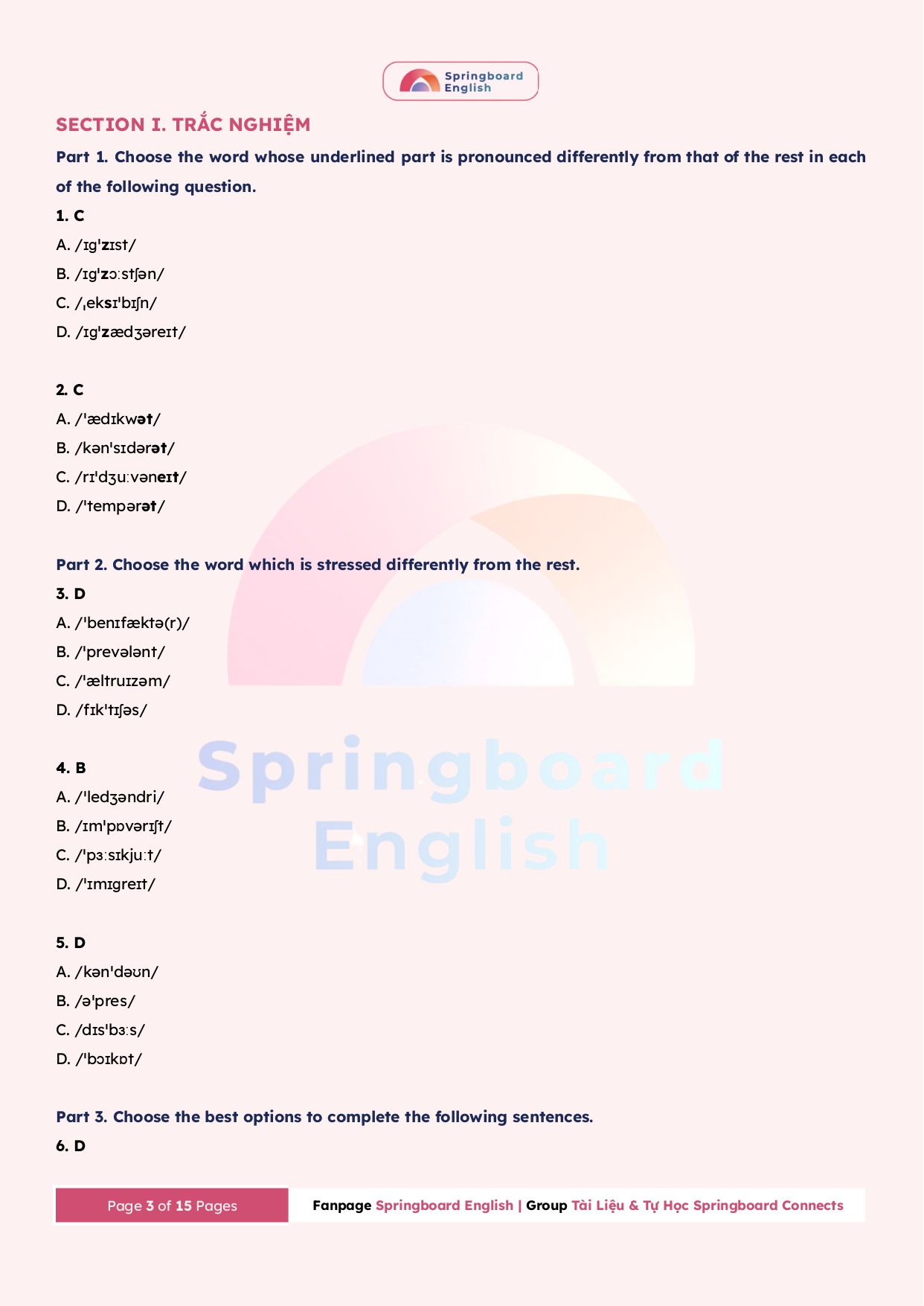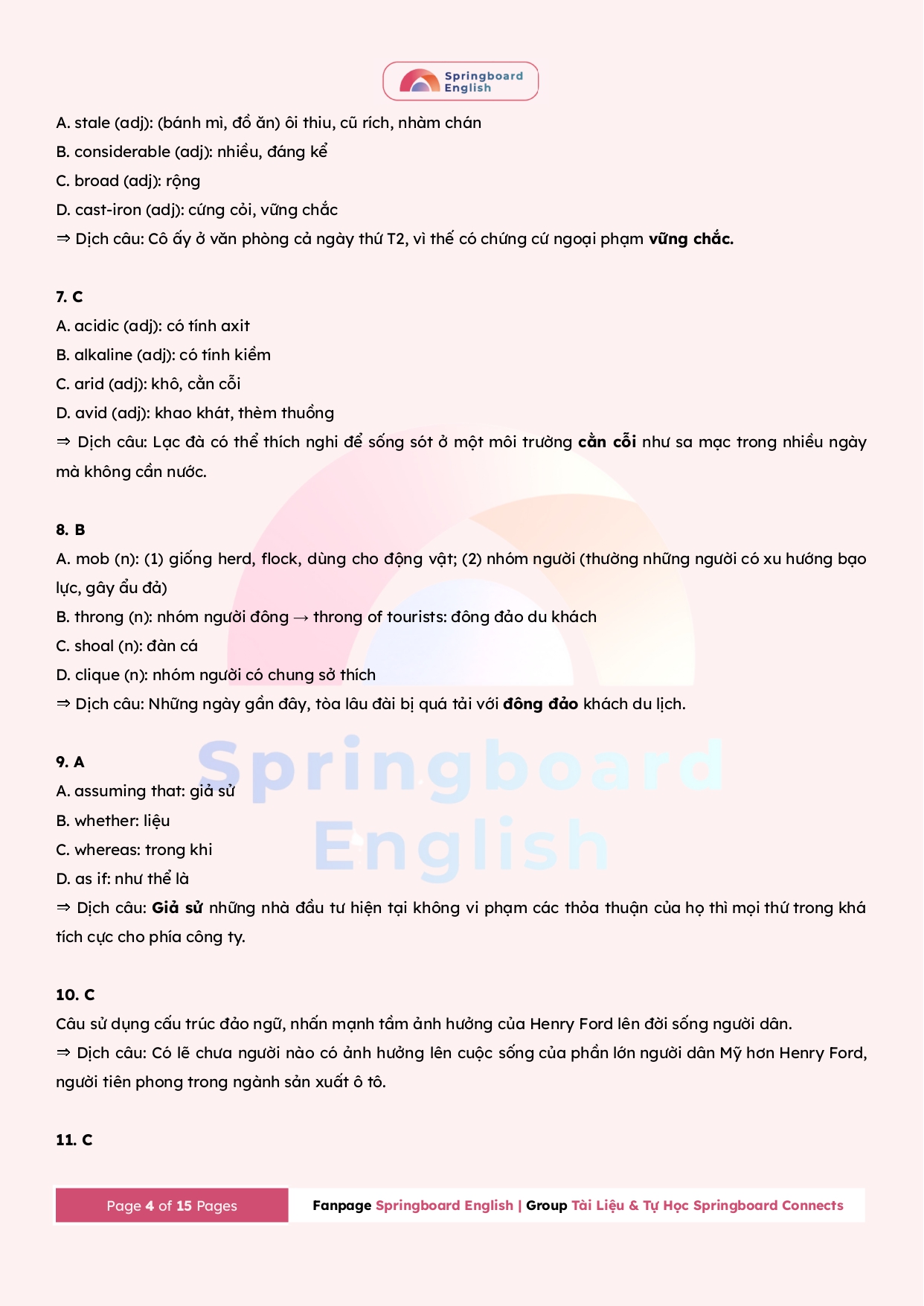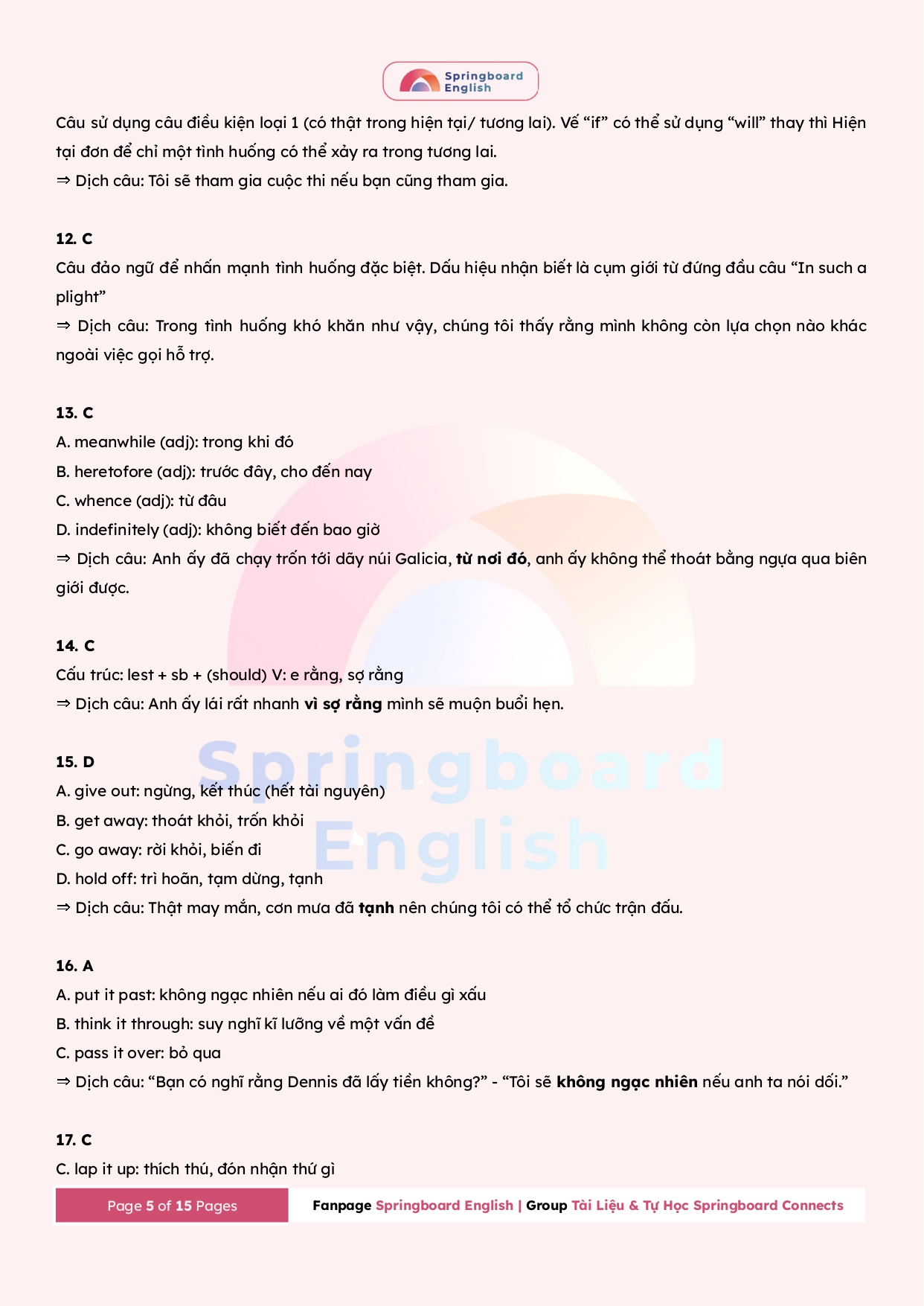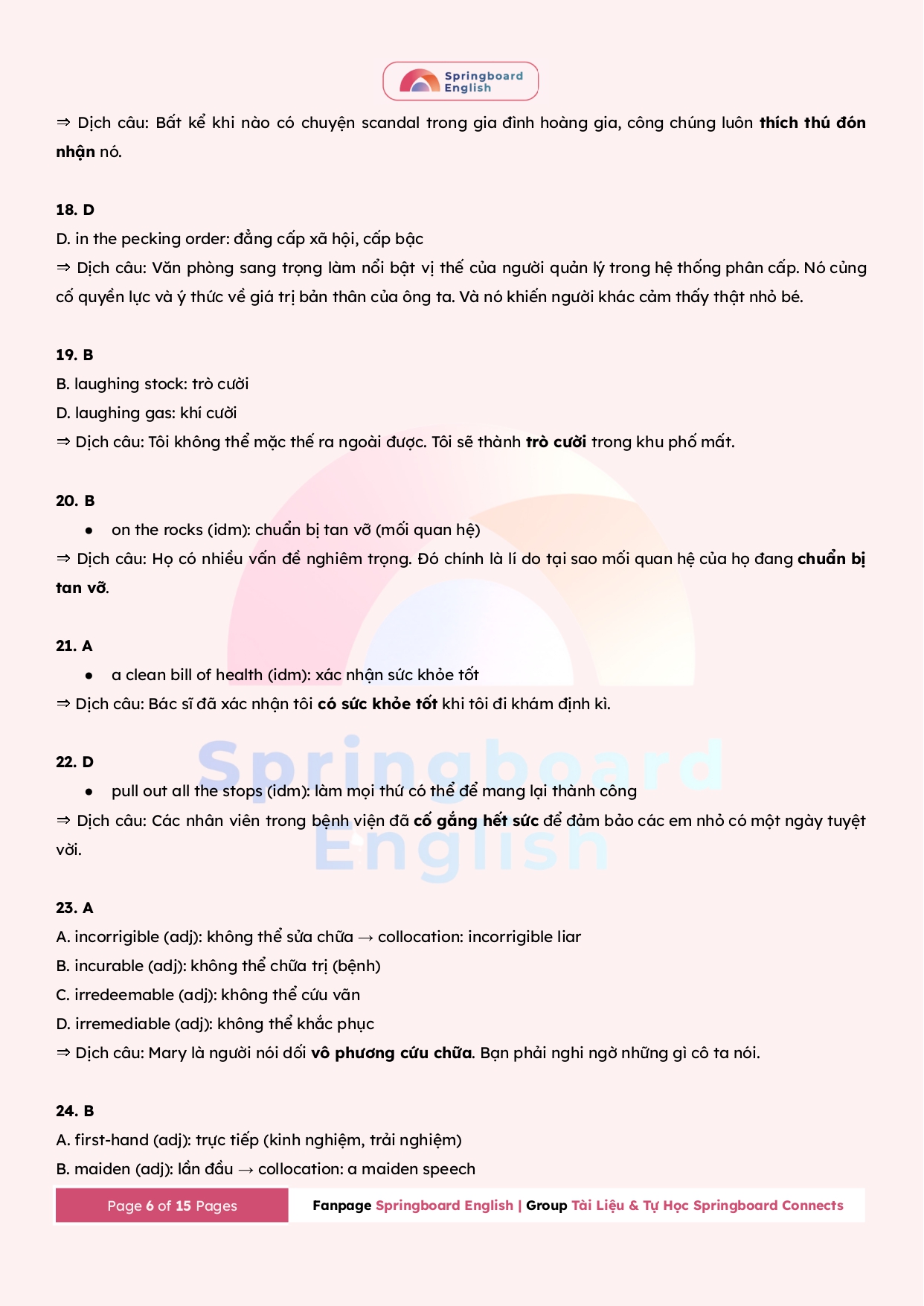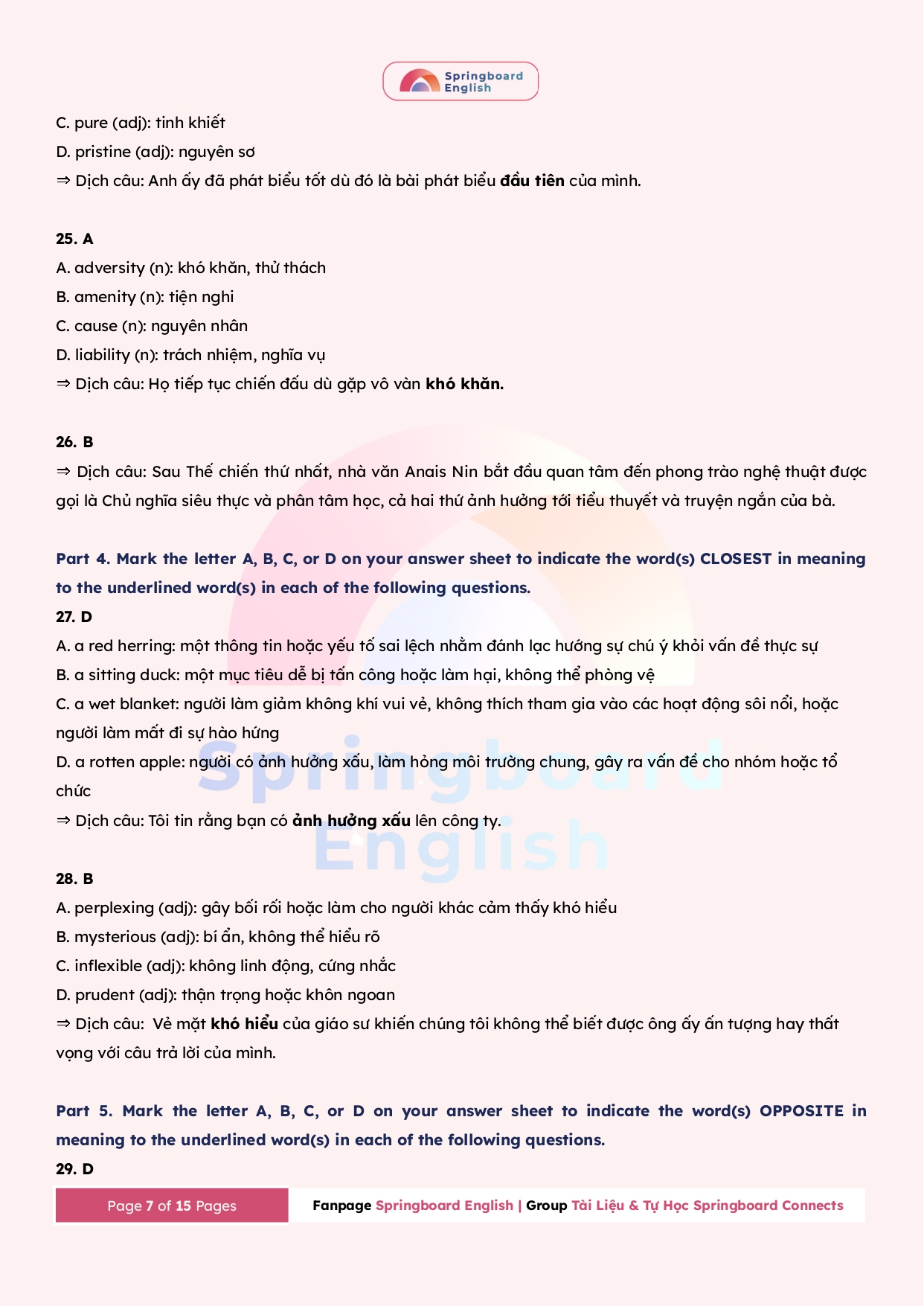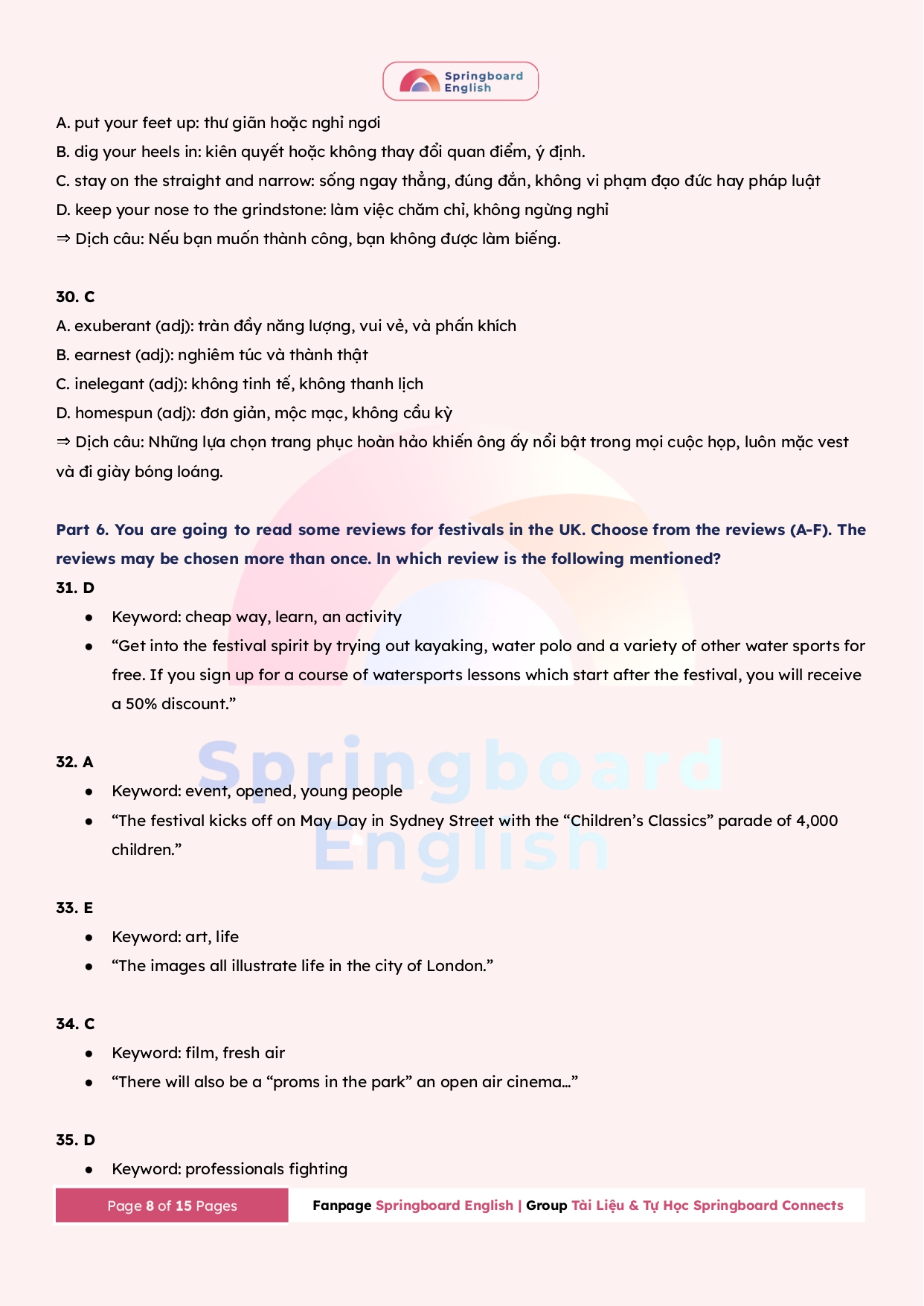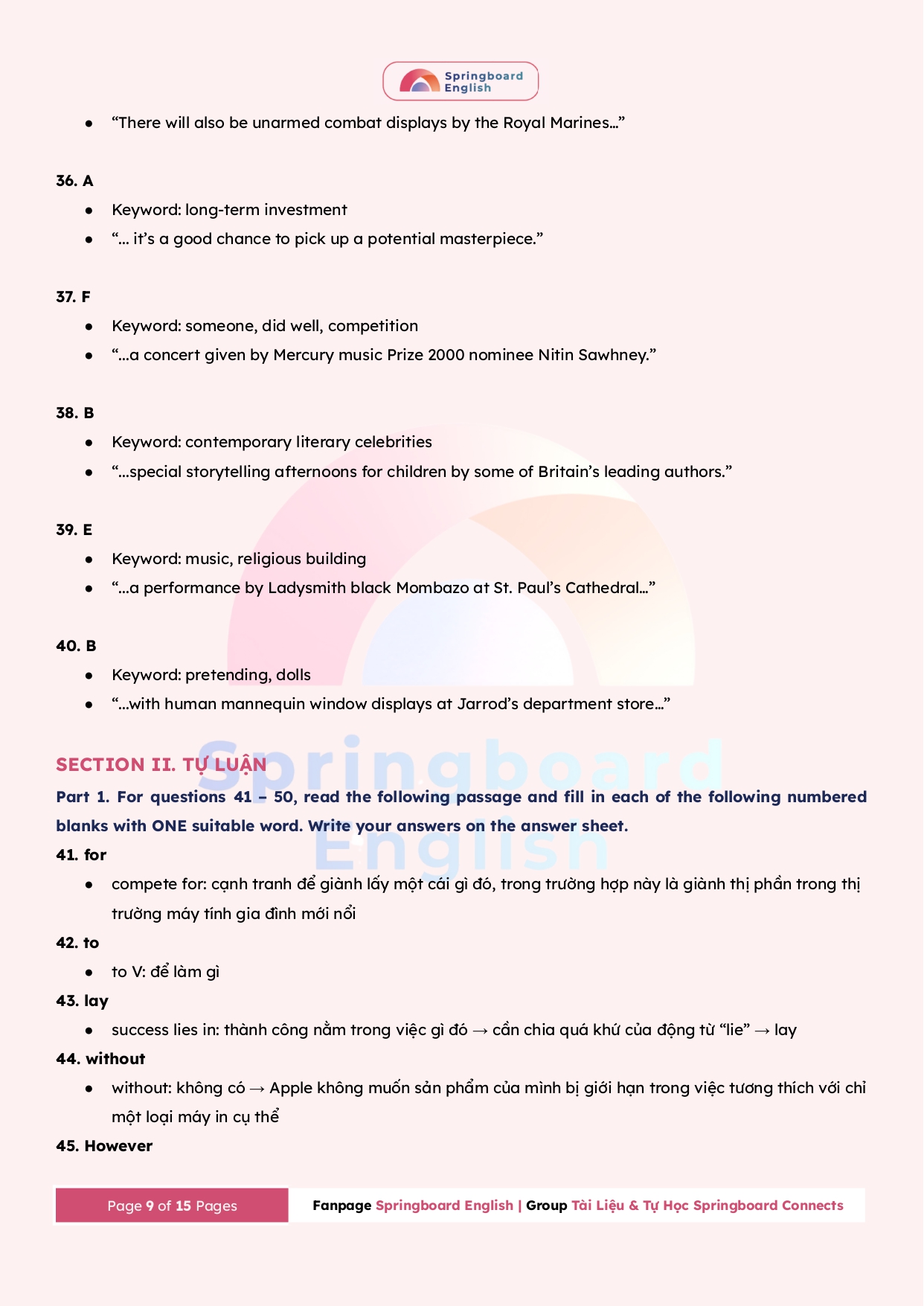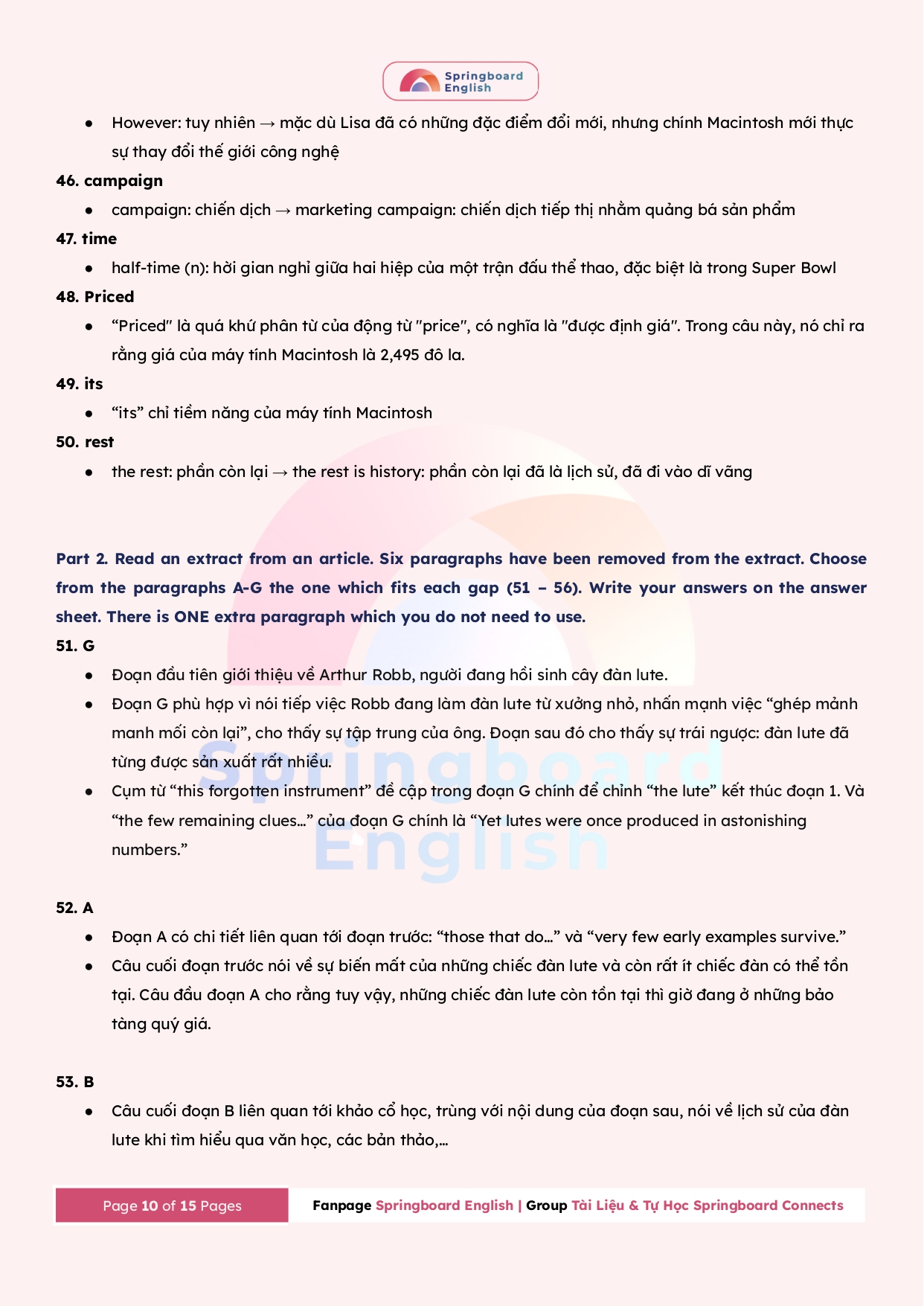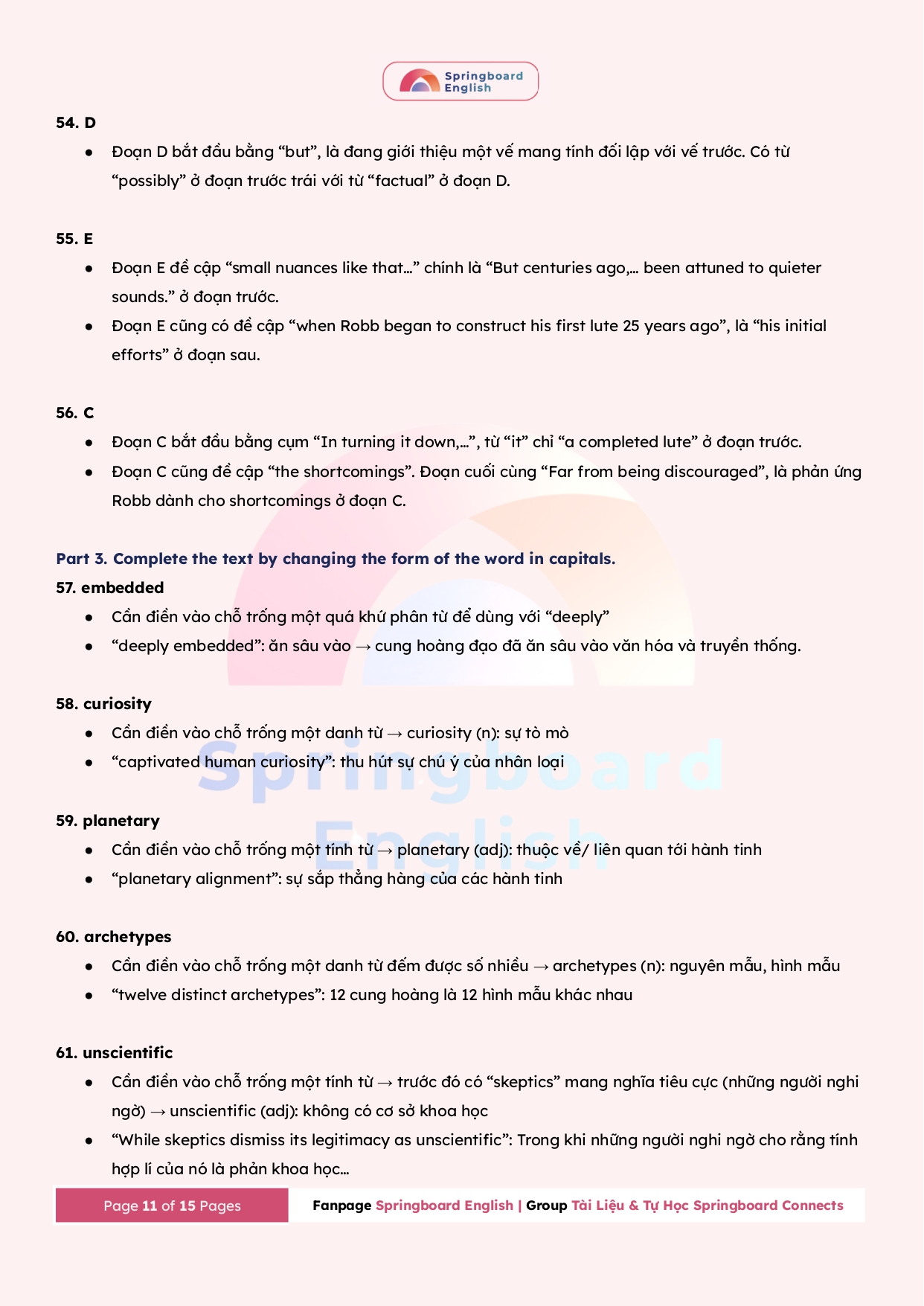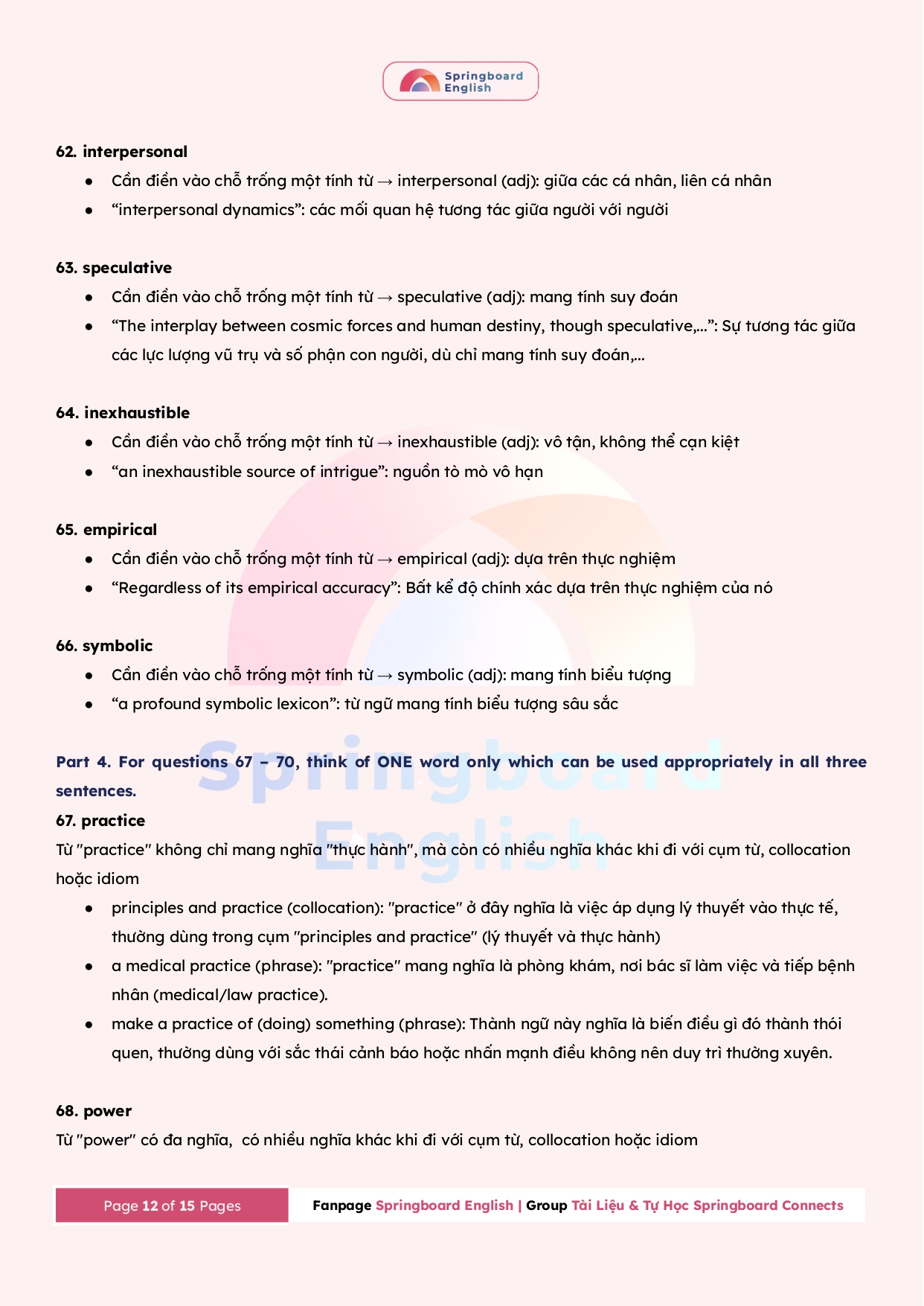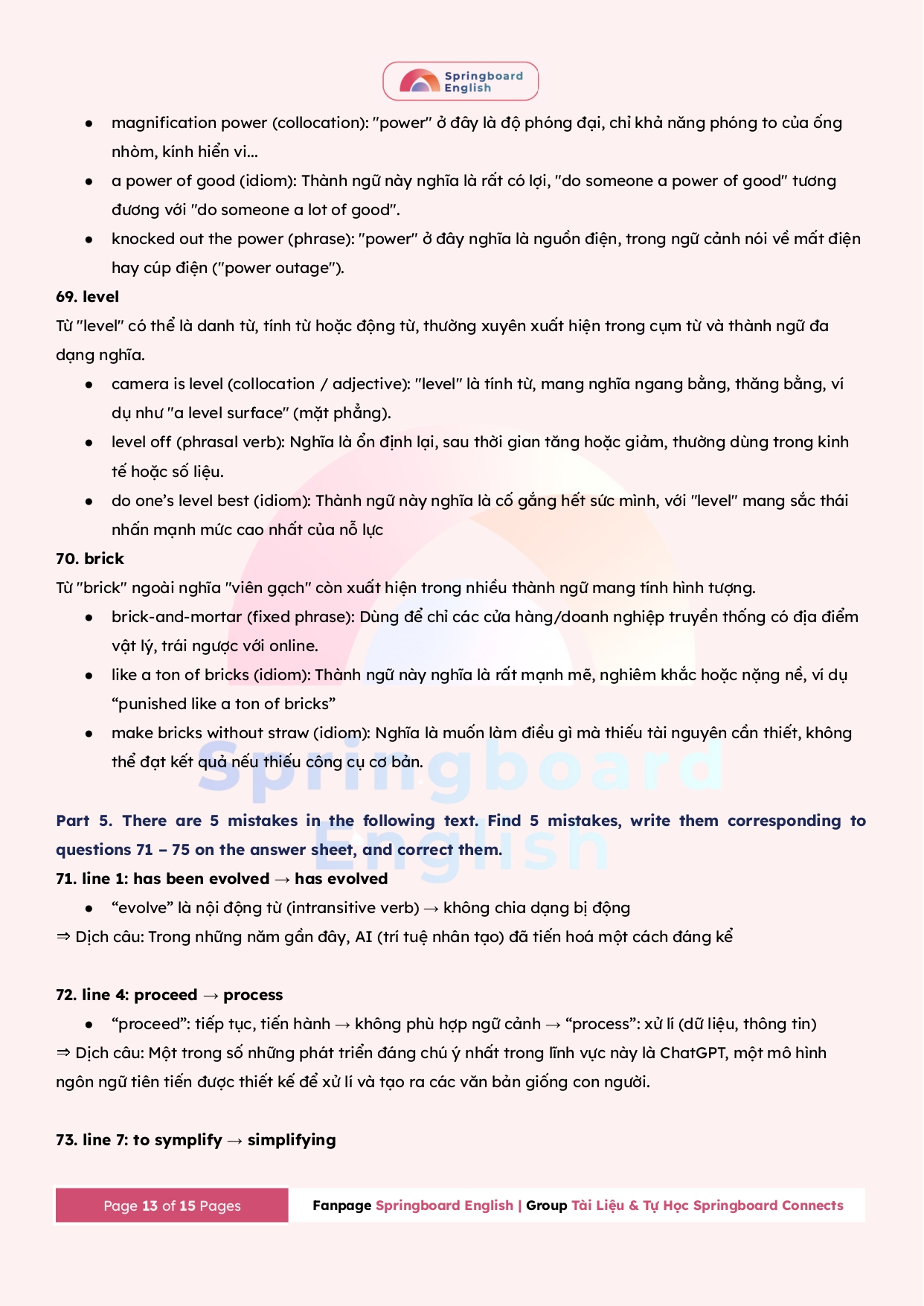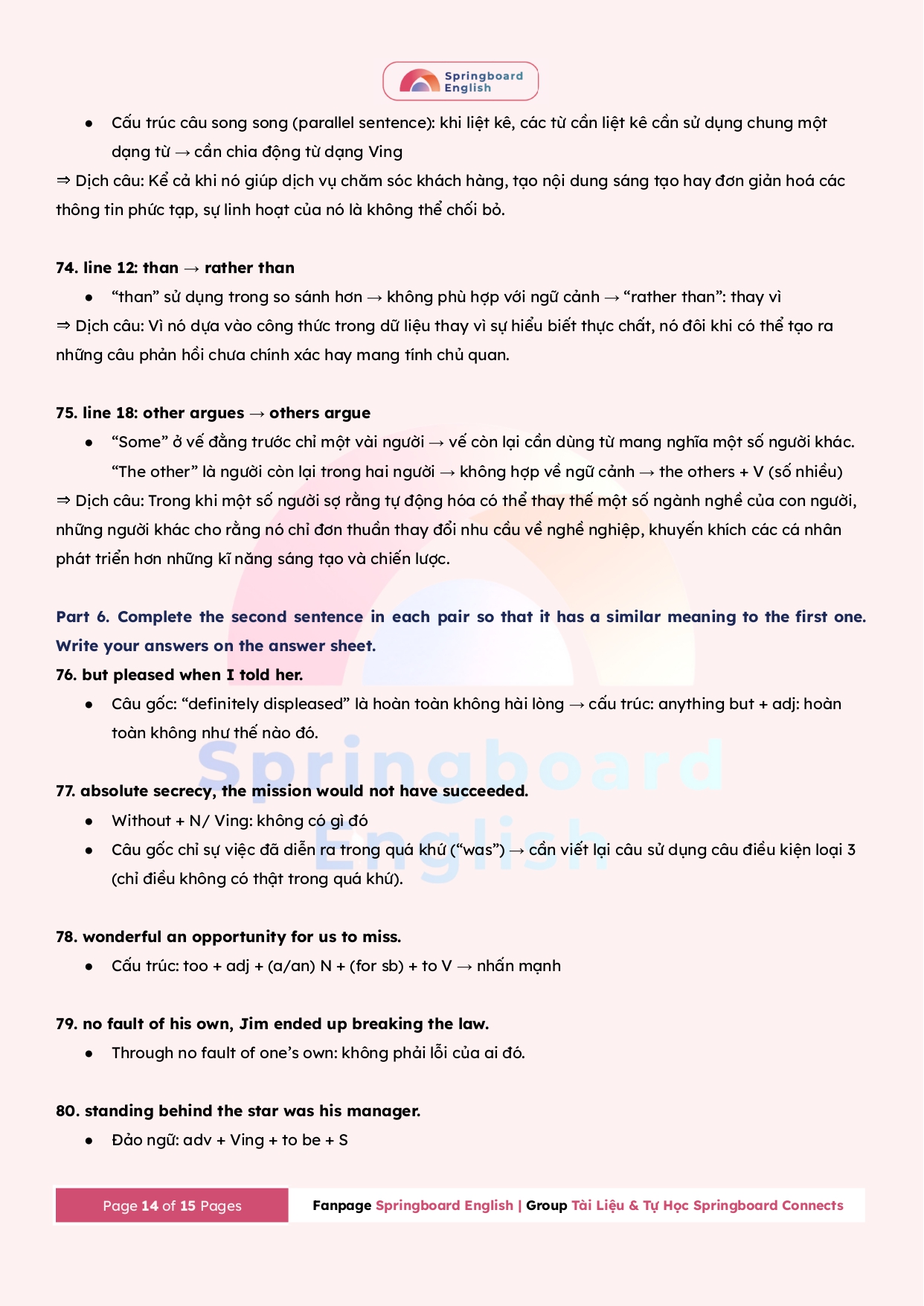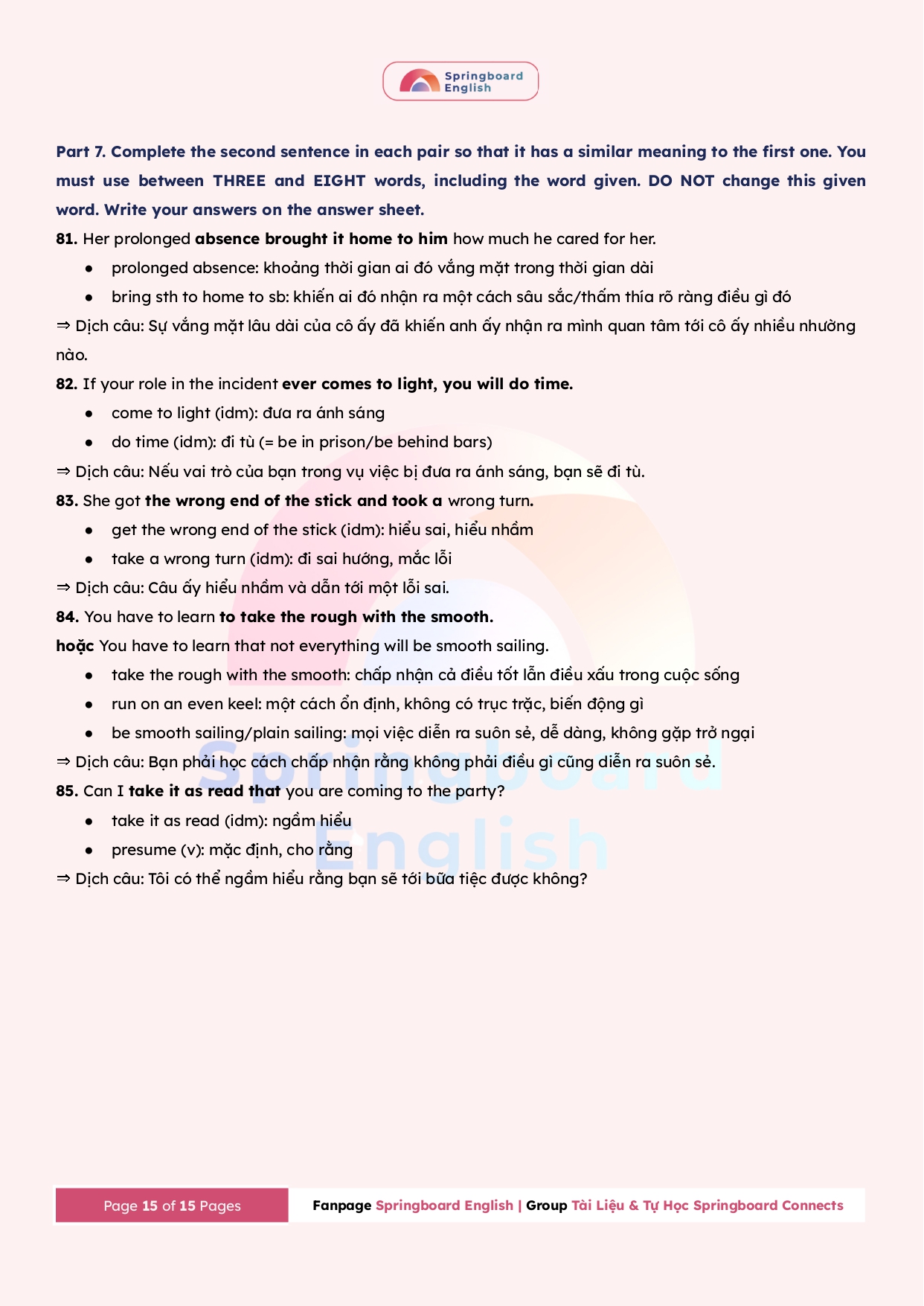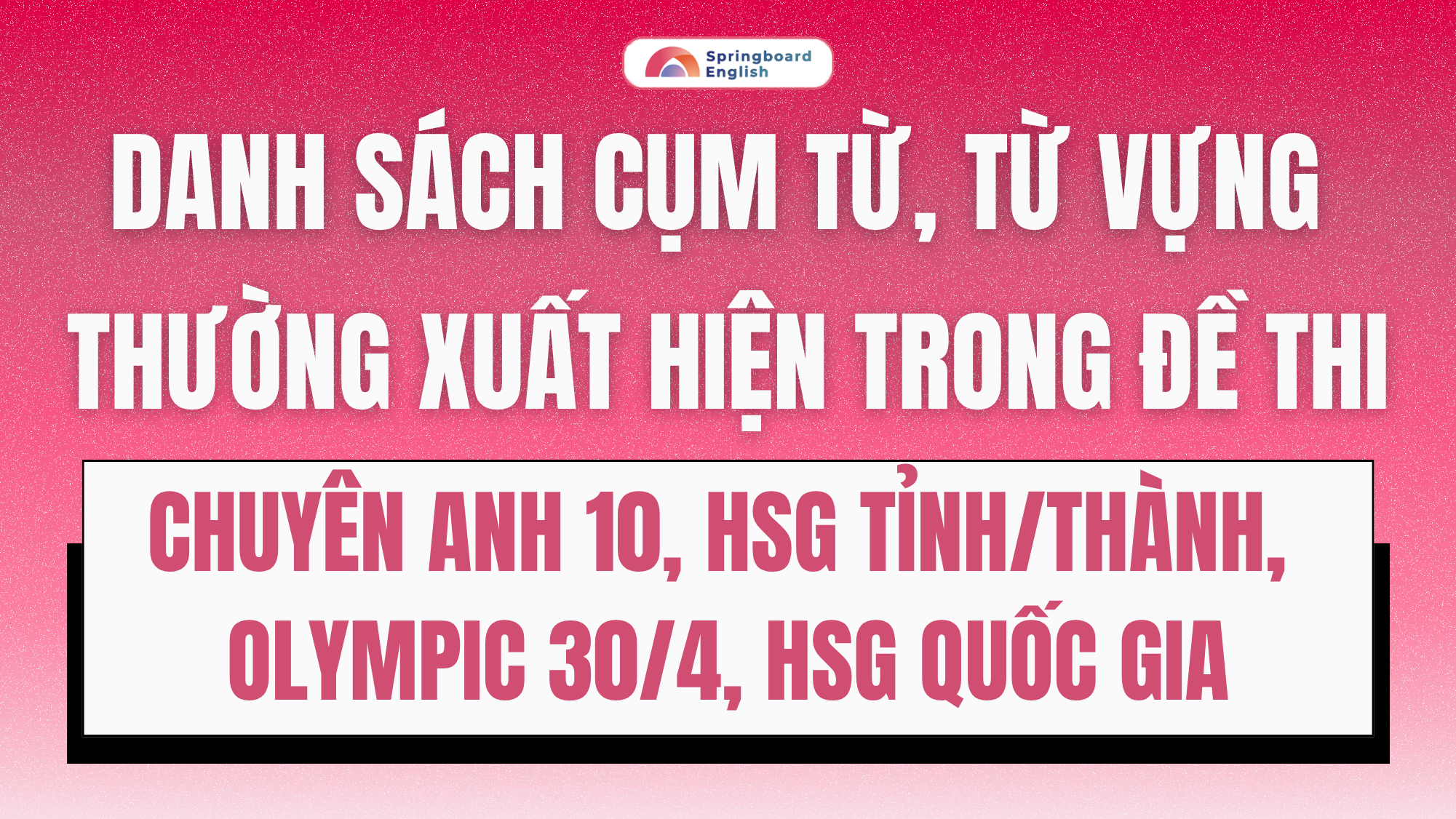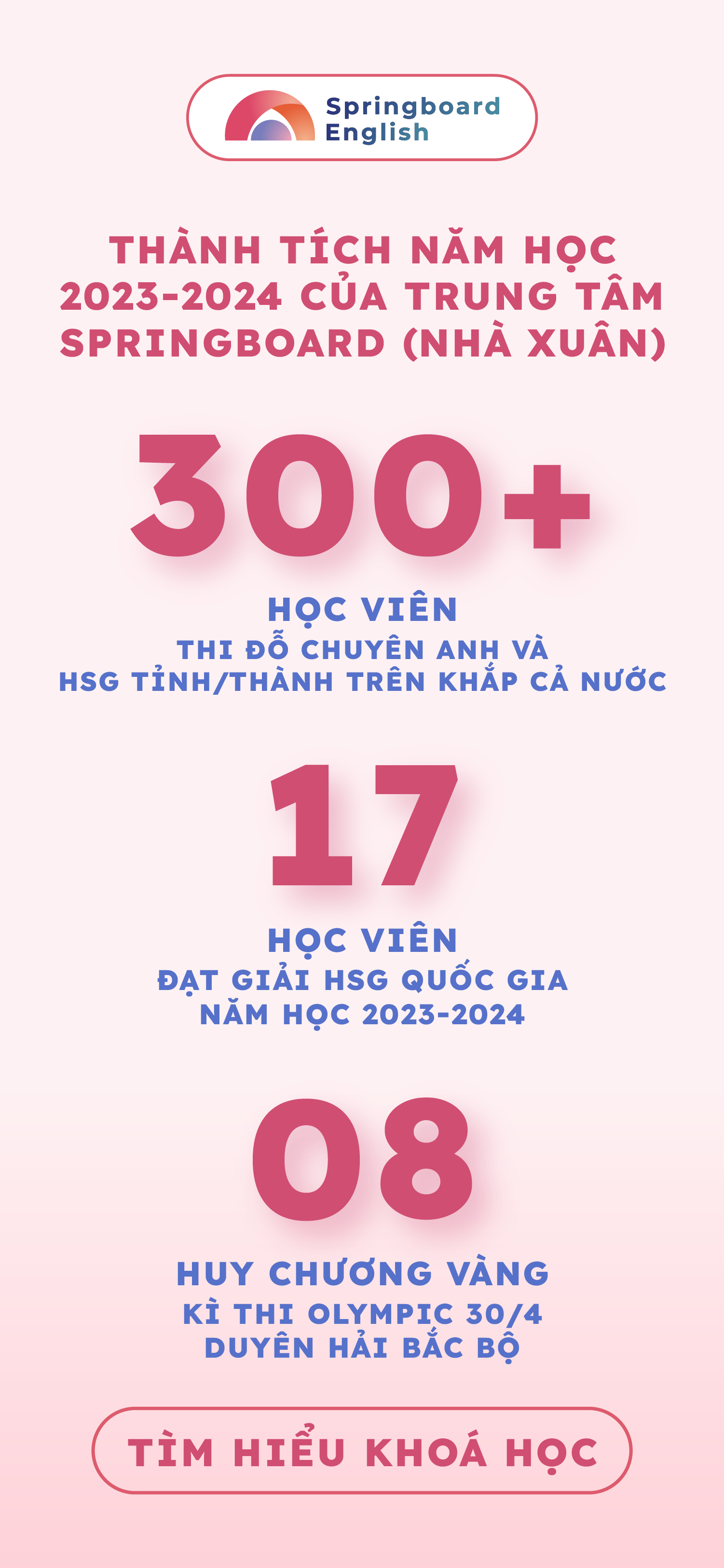| ĐỀ CHUYÊN ANH THÁI BÌNH 2025-2026 |
SECTION A. LISTENING (2.0 pts)
- The listening section is in FOUR parts. You will hear each part TWICE. At the beginning of each part, you will hear a sound.
- There will be a piece of music at the beginning of the listening section. You will have TWO minutes to check your answers at the end of the listening section.
- All the other instructions are included in the recording.
Part 1. For questions 1 – 5, listen to two people talking about accommodation options at Sunnyside Holiday Park and fill in each blank with ONE WORD.
| Accommodation at Sunnyside Holiday Park |
Motel rooms
- $205; sleep 2 people
- all rooms have a view of the (1) ______
Studios
- $155; sleep 4 people
- no kitchen but a kettle and a (2) ______ for making drinks and snacks
Budget units
- $222; sleep 4 people
- kitchen with a fridge and a (3) ______
- need to bring your own (4) ______
Other facilities
- laundry
- games room for all ages
- a (5) ______ for guests under 12
|
Your answers:
Part 2. For questions 6 – 10, listen to a piece of news about cancer and fill in each blank with NO MORE THAN TWO WORDS.
- Cancer is responsible for one in every seven deaths globally and begins when a genetic change ______ the regulation of the growth and division of cells, making them grow uncontrollably.
- When these genes malfunction, abnormal cell growth forms tumors, which can be ______ or malignant. Malignant tumors can spread to other parts of the body through metastasis, becoming particularly dangerous.
- The exact cause of cancer is unknown, but ______ and environmental factors like radiation and smoking may contribute.
- In the U.S., about one-third of people will develop cancer, with ______ cancer being the most common and lung cancer the deadliest.
- Advances in treatment and early detection have led to a 26% drop in cancer ______ since the 1990s, offering hope in the fight against the disease.
Your answers:
Part 3. For questions 11 – 15, listen to a report on frogs and choose the answer A, B, or C which fits best according to what you hear.
- What is the report mainly about?
| A. The importance of fungus to frog life |
| B. Common habitats of frogs in the wild |
| C. A decrease in worldwide frog populations |
- How does chytrid fungus affect frogs?
| A. It poisons their food supply. |
| B. It harms their skin. |
| C. It causes them to avoid water. |
- Why does the biologist mention zoos?
| A. to indicate the source of chytrid fungus. |
| B. to compare the frog habitats in captivity to those in the wild. |
| C. to explain where some frogs are being treated. |
- What does the biologist say about shipping frogs internationally?
| A. Governments should ban the shipping of frogs. |
| B. Frogs should not be delivered until proven healthy. |
| C. Healthy frogs should not be transported. |
- According to the reporter, how can listeners address the problem?
| A. by contributing to an animal organization. |
| B. by contacting their government officials. |
| C. by visiting their local zoos. |
Your answers:
Part 4. For questions 16 – 20, listen to two ecologists, called Jack Benson and Trisha Roberts, talking about sand and decide whether the following statements are True (T) or False (F) according to what you hear.
- Jack thinks the main reason people are attracted to beaches is because the sound of the waves is hypnotic.
- When Trisha read an article about ‘pop-up’ beaches, she was ashamed of having visited one.
- Jack and Trisha agree that the practice of adding fresh sand to beaches must be harmful to the wildlife there.
- Jack mentions the fact that more people live in cities nowadays to criticise people’s lack of awareness of environmental issues.
- Trisha is particularly concerned that removing sand from beaches may result in a change in the lifestyle of coastal communities.
Your answers:
SECTION B. VOCABULARY & GRAMMAR (2.5 pts)
Part 1. For questions 21 – 35, choose the best answer to complete each of the following sentences.
- ______ she went back to her room.
| A. There was no cause for alarm |
B. Without having cause for alarm |
| C. There being no cause for alarm |
D. Being no cause for alarm |
- It is an ______ that the most talented artists often go completely unrecognized in their lifetime.
| A. irregularity |
B. eccentricity |
C. anomaly |
D. abnormality |
- My father supposes, ______ that he will be retiring at sixty.
| A. like most people did |
B. like most people will |
| C. as are most people |
D. as do most people |
- The committee was insistent that the decision ______ to avoid potential consequences.
| A. be reversed |
B. was reversed |
C. will be reversed |
D. should reverse |
- ______ results that differed from previous experiments, the researchers were shocked at the most recent data.
| A. Since the expectation of |
B. While they expected |
| C. Although the expected |
D. Expected though they were |
- Rebecca Crittenden wrote several successful novels, ______ her beautifully illustrated children’s books that she is most famous for.
| A. yet they are |
B. and is it |
C. so these are |
D. but it is |
- He must have taken a wrong turn; otherwise, he ______ here an hour ago.
| A. would be arriving |
B. should arrive |
C. would have arrived |
D. arrived |
- Duke Ellington’s orchestra, ______ his own often complex compositions, made many innovations in jazz.
| A. he played |
B. playing |
C. that it played |
D. was playing |
- Until a ______ agreement has been reached, I am not committed to accepting the offer.
| A. hard |
B. stable |
C. firm |
D. fickle |
- Their solution was both innovative and ______, allowing for long-term sustainability.
| A. profound |
B. viable |
C. ambitious |
D. illegible |
- In Europe, ______ most cities are still designed for the old modes of transport; adaptation to ______ motor car has involved adding ring roads, one-way systems and parking lots.
| A. the/ a |
B. the/ no article |
C. no article/ the |
D. no article/ a |
- The cyberattack that caused a lot of damage is believed ______ by a group of hackers targeting financial institutions.
| A. to be launched |
B. to have launched |
| C. to have been launched |
D. to be launching |
- Instead of taking responsibility for the failure of the project, the manager tried to ______ to his subordinates, which only worsened the team’s morale.
| A. call it a day |
B. pass the buck |
C. read between the lines |
D. sit on the fence |
- The Red Cross is ______ an international aid organization.
| A. intriguingly |
B. intrusively |
C. intrinsically |
D. intrepidly |
- Crops are often completely destroyed by ______ of locusts.
| A. bands |
B. troupes |
C. swarms |
D. flocks |
Your answers:
| 21. |
22. |
23. |
24. |
25. |
|
|
|
|
|
| 26. |
27. |
28. |
29. |
30. |
|
|
|
|
|
| 31. |
32. |
33. |
34. |
35. |
|
|
|
|
|
Part 2. For questions 36 – 40, provide the correct form of the words in the brackets.
Pablo Picasso (1881-1973) is generally considered to be the (
36. MOST) ______ figure of the 20
th century art. Trained by his father, an art professor, he was a technically skilled draftsman and painter from an early age, and went on to produce an incredible number and range of works, including sculptures, drawings, ceramics and designs for theatrical production. Picasso’s works all show great originality and he was an influential figure for his contemporaries as well as later artists.
It is (
37. CUSTOM) ______ to discuss Picasso’s works in terms of a series of periods. In his Blue Period (1901-1904), Picasso’s paintings depicted social (
38. CAST) ______ such as beggars and prostitutes, and these melancholy paintings are characterized by the use of the color blue in various shades. In the Rose Periods, beginning around 1904, Picassos’ palette (
39. BRIGHT) ______ to include pinks and beige, and his choice of subjects also showed more warmth and optimism. Breaking with traditional ideas of artistic harmony, Picasso went on to develop the Cubist style, in collaboration with his friend Georges Braque. His early cubist pictures show the (
40. INSPIRE) ______ of primitive African statues, with figures with mask-like faces and flat, angular shapes.
Your answers:
Part 3. For questions 41 – 45, identify the 5 mistakes in the following passage and write the corrections in the table provided.
(0) What is the abilities that a professional sports person needs? (1) To guarantee that opponents can be overcome, speed, stamina, and agility are essential, not to mention outstanding natural talent. (2) Both a rigorous and comprehensive fitness regime and a highly nutritional diet are vital for top-level performance. (3) It is carbohydrates, rather than proteins, that provide athletes with the endurance they need to compete. (4) This means that pasta is more beneficial than eggs or meat. (5) Such a diet enables them to move very energetically when requiring. (6) Failure to follow a sensible diet can result in the ability to maintain stamina. (7) Regular training to increase muscular strength is also a vital part of a professional’s regime, and this is typical done by exercising with weights. (8) Sports people are prone for injuries but a quality training regime can ensure that the severity of these can be minimised.
Your answers:
| Questions |
Sentence No. |
Mistakes |
Corrections |
| 0 |
0 |
is |
are |
| 41. |
|
|
|
| 42. |
|
|
|
| 43. |
|
|
|
| 44. |
|
|
|
| 45. |
|
|
|
SECTION C. READING (3.0 pts)
Part 1. For questions 46 – 50, read the passage and choose the best answer to fill in each blank.
The media has a big (46) ______ on what people think and how they behave. That’s why it is important to think carefully about the information we read, watch, or listen to. (47) ______, the media can give us news, entertain us, and try to change our opinions.
One of the main purposes of the media is to provide people with important information about what is happening around them. (48) ______. The media also has the power to influence people’s opinions and behaviors. For example, news stories can change the way people think about social or political issues. By reporting on current events, the media keeps the public informed and helps to hold those in power accountable.
In addition to informing, the media also entertains. (49) ______. Whether it’s through movies, music or video games, the media offers a variety of forms of entertainment that can help people relax, escape and connect with others.
However, the media also has the potential to be misused. By reporting on current events, the media can shape public opinion. The media can be used to entertain and inspire. By evaluating the credibility of sources, identifying biases and seeking diverse perspectives, individuals can make (50) ______ decisions and avoid being manipulated.
| A. reaction |
B. consequence |
C. impact |
D. intention |
| A. Whether it is newspapers, television, or online platforms |
| B. That it is newspapers, television, or online platforms |
| C. Which includes newspapers, television, or online platforms |
| D. Whatever platform it uses, which includes newspapers, television, and the internet |
| A. This helps people understand the world and make better decisions in their daily lives. |
| B. That helps people understand the world and make better decisions in their daily lives. |
| C. While it helps people understand the world and make better decisions in their daily lives. |
| D. What helps people understand the world and make better decisions in their daily lives. |
| A. Entertainment content is a powerful aspect of modern media. |
| B. A powerful aspect is an entertainment content of modern media. |
| C. Modern media has an entertainment content of powerful aspect. |
| D. Modern media consists of entertainment content and a powerful aspect. |
| A. aware |
B. informed |
C. confident |
D. active |
Your answers:
Part 2. For questions 51 – 55, read the passage and fill in each blank with ONE word.
The Power of Saying Sorry
Saying sorry is not something (51) ______ comes easily to many people. I know I couldn’t for a very long time. I was too self-righteous and arrogant to be able to apologize. I learned how to behave like this from my father, and then I met my match – a boyfriend who made me look at my own actions. Now I’ve learned that not only do we all make mistakes but what a magnificent gift it is to be able to admit them, and then apologize as well.
Of course, not all apologizing is powerful. The British tend to say sorry too often, as a way of pleasing other people. It’s glib and without any real feeling, but it’s a polite formula in certain (52) ______ situations. Powerful saying sorry is about real (53) ______ – it’s honest and heartfelt. Traditionally, in Britain, saying sorry has been taken to mean backing (54) ______, losing the argument or being weak – I’ve certainly been guilty of thinking this in the past. But there are real signs that times are changing. “As a society, we know more about psychology”, says counsellor Paula Hall. “We are learning that saying sorry is about allowing yourself to be vulnerable, which is actually a sign of strength, not (55) ______. You learn from experience that saying sorry increases people’s respect for you, rather than diminishing it.”
(Adapted from CAE Gold Plus)
Your answers:
Part 3. For questions 56 – 65, read the following passage and choose the letter A, B, C, D to indicate the best answer to each question.
No longer is asthma considered a condition with isolated, acute episodes of bronchospasm. Rather, asthma is now understood to be a chronic inflammatory disorder of the airways – that is, inflammation makes the airways chronically sensitive. This shift in understanding has changed how asthma is diagnosed and treated. When these hyperresponsive airways are irritated, airflow is limited, and attacks of coughing, wheezing, chest tightness and breathing difficulty occur.
Asthma involves complex interactions among inflammatory cells, mediators, and the cells and tissues in the airways. The interactions result in airflow limitation from acute bronchoconstriction, swelling of the airway wall, increased mucus secretion, and airway remodeling. The inflammation also causes an increase in airway responsiveness. During an asthma attack, the patient attempts to compensate by breathing at a higher lung volume in order to keep the air flowing through the
constricted airways, and the greater the airway limitation, the higher the lung volume must be to keep airways open. The morphologic changes that occur in asthma include bronchial infiltration by inflammatory cells. Key effector cells in the inflammatory response are the mast cells, T lymphocytes, and eosinophils. Mast cells and eosinophils are also significant participants in allergic responses, hence the similarities between allergic reactions and asthma attacks. Other changes include mucus plugging of the airways, interstitial edema, and microvascular leakage. Destruction of bronchial epithelium and thickening of the subbasement membrane are also characteristic. In addition, there may be hypertrophy and hyperplasia of airway smooth muscle, increase in goblet cell number, and enlargement of submucous glands.
Although causes of the initial tendency toward inflammation in the airways of patients with asthma are not yet certain to date, the strongest identified risk factor is atopy. [I] This inherited familial tendency to have allergic reactions includes increased sensitivity to allergens that are risk factors for developing asthma. [II] Some of these allergens include domestic dust mites, animals with fur, cockroaches, pollens, and molds. [III] By avoiding these allergens and triggers, a person with asthma lowers his or her risk of irritating sensitive airways. [IV] A few avoidance techniques include: keeping the home clean and well ventilated, using an air conditioner in the summer months when pollen and mold counts are high, and getting an annual influenza vaccination. Of course, asthma sufferers should avoid tobacco smoke altogether. Cigar, cigarette, or pipe smoke is a trigger whether the patient smokes or inhales the smoke from others. Smoke increases the risk of allergic sensitization in children, increases the severity of symptoms, and may be fatal in children who already have asthma.
Many of the risk factors for developing asthma may also provoke asthma attacks, and people with asthma may have one or more triggers, which vary from individual to individual. The risk can be further reduced by taking medications that decrease airway inflammation. Most
exacerbations can be prevented by the combination of avoiding triggers and taking anti-inflammatory medications. An exception is physical activity, which is a common trigger of exacerbations in asthma patients. However, asthma patients should not necessarily avoid all physical exertion, because some types of activity have been proven to reduce symptoms. Rather,
they should work in conjunction with a doctor to design a proper training regimen, which includes the use of medication.
In order to diagnose asthma, a healthcare professional must appreciate the underlying disorder that leads to asthma symptoms and understand how to recognize the condition through information gathered from the patient’s history, physical examination, measurements of lung function, and allergic status. Because asthma symptoms vary throughout the day, the respiratory system may appear normal during physical examination. Clinical signs are more likely to be present when a patient is experiencing symptoms; however, the absence of symptoms upon examination does not exclude the diagnosis of asthma.
- What is the main idea of the passage?
| A. Asthma is a mild condition best treated through physical exercise and does not require long-term medication from doctors’ management. |
| B. Asthma is a chronic disease with inflammatory, genetic, and environmental causes, requiring personalized diagnosis and management. |
| C. Asthma mainly results from viral infections and should be confirmed through continuous physical monitoring. |
| D. Asthma patients should avoid exercise entirely and rely mainly on environmental control to reduce attacks. |
- What physiological response occurs in asthma patients to compensate for restricted airways during an attack?
| A. They reduce their breathing rate to stabilize oxygen levels. |
| B. They breathe at a higher lung volume to maintain airflow. |
| C. Their airways begin to dilate naturally without medical intervention. |
| D. Their immune system produces antibodies to restore airflow. |
- Which of the following is OPPOSITE in meaning to the word constricted in bold in paragraph 2?
| A. narrow |
B. restricted |
C. dilated |
D. hollow |
- Why is atopy considered a major concern in asthma development?
| A. It leads to increased lung capacity in asthma patients. |
| B. It suppresses the immune system and allows allergens to accumulate. |
| C. It causes heightened sensitivity to allergens that are asthma triggers. |
| D. It protects children from developing respiratory infections. |
- Where in paragraph 3 does the following sentence best fit?
“Additionally, asthma may be triggered by viral respiratory infections, especially in children.”
| A. [I] |
B. [II] |
C. [III] |
D. [IV] |
- According to paragraph 3, which of the following is NOT recommended for people with asthma?
| A. Keeping homes well-ventilated |
B. Using air conditioners in summer |
| C. Getting vaccinated for influenza |
D. Engaging in any kind of physical activity |
- Which of the following would be the best replacement for the word exacerbations in bold in paragraph 4?
| A. allergies |
B. attacks |
C. triggers |
D. allergens |
- The word they in bold in paragraph 4 refers to ______.
| A. patients |
B. triggers |
C. medications |
D. symptoms |
- Which of the following can be inferred from the passage?
| A. All people with asthma share the same triggers when they try to compensate for the air. |
| B. Asthma symptoms always appear during physical examinations. |
| C. Asthma is best diagnosed based solely on physical signs such as coughing and breathing difficulty. |
| D. Diagnosis of asthma can be difficult because symptoms vary throughout the day. |
- According to the passage, which of the following is TRUE about physical activity in asthma patients?
| A. Asthma patients should avoid all forms of physical activity to prevent severe exacerbations. |
| B. Physical activity never triggers asthma attacks if the patient is taking medication. |
| C. Physical activity can trigger asthma but may also help reduce symptoms when managed properly. |
| D. Doctors generally recommend that asthma patients stop exercising altogether to avoid health risks. |
Your answers:
| 56. |
57. |
58. |
59. |
60. |
|
|
|
|
|
| 61. |
62. |
63. |
64. |
65. |
|
|
|
|
|
Part 4. For questions 66 – 70, read the following passage and choose the correct headings for sections A-E from the list of headings below.
Why computer games are good for your child?
A. The idea of bringing computer games in the classroom seems likely to provoke detentions rather than learning. But that’s slowly changing. To some, they may be playing Sim City, to others, they are learning geography. To some, they are playing fantasy football; to others they are learning maths and strategy skills. Gaming whether online, on a console or on a computer is thought by many teachers and parents to be the classic signs of a modern wasted youth. Where once it was snooker halls, now it’s Lara Croft and her legions of imitators as the classic signs of a life frittered away.
B. But some educationalists beg to differ, saying that gaming extends and improves a whole range of skills and aptitudes and can benefit learning. Indeed, in a survey for the technology and investment company Nesta Futurelab, earlier this year, a third of teachers are already using computer games and believe they improved skills. Out of the survey of 1000 teachers, 91% thought they developed motor and cognitive skills, and 60% believed they would develop thinking skills and acquire specific knowledge. We are faced with a gaming generation of children who spend their time and money on online and computer games. At the very least, this makes them technically literate – often more so than their teachers, who can feel embarrassed on occasion by a perceived lack of skills compared to the kids in front of them. A report last year by the University of Bristol found that teachers were happy using computers at home, but would not take the risk of getting it wrong in front of a class of pupils and, partly as a result, some 30% of teachers surveyed failed to make good use of computers in the classroom. But there is a growing feeling that games can be useful learning tools and do, in fact, help children develop and can even build social skills (children prefer gaming in small groups). For one thing, as any adult who has tried them will tell you, the games themselves are actually hard, requiring a significant number of skills – hand-eye coordination, multi-tasking, strategy and the management of complex variables, communication, literacy and problem-solving, on top of the necessary computer skills.
C. Specific games can be used for specific subjects – schools do use Sim City (the simulation planning and strategy game), either as special education versions or as the commercial product, to help teaching geography. Others prefer to use games developed specifically for learning purposes. Researchers at the technology developers Nesta Futurelab have, for example, developed Astroversity, a space rescue mission that gets children to collaborate in order to rescue victims after a disaster in a space station. Even a football management game requires the ability to interrogate huge databases of information and make complex decisions, and usually without the child noticing.
D. And that can be the beauty of games in the classroom – the problem of motivating students can disappear when they are confronted with familiar and enjoyable tasks. It becomes far less difficult to persuade them to work on their own and even in their own time. Pride and satisfaction become drivers in motivating children to perform well against each other and provides a way for children to interact with each other (off-screen) with gaming leagues and the like. Of course, assessment of game-based coursework can be difficult (not least if you insist that it isn’t the winning that matters) and the application of games to the national curriculum can be tenuous.
E. Of course, trying to co-opt games into the classroom is not without problems. For one, the games are built to obsess users – getting them so absorbed that turning away is a real problem. Engagement can be great – up to a point. Getting them to turn back to mainstream educational methods can be a problem and introducing such a youth culture into the classroom can be an issue – pupils may take it less seriously and parents could be horrified. The selection of games too can be an issue. Teaching citizenship via Grand Theft Auto may be a winner with some of the pupils but is likely to provoke a rather unhappy reaction elsewhere. Violence generally is a problem of the selection process and needs policing – in the same way as allowing children access to the web. Issues of the role of women in such games need to be addressed before large-bosomed heroines with machine guns become teaching aids.
https://www.theguardian.com/education/btchildsafetyonline/story
List of headings
- Educational applications of subject-specific games
- How gaming reduces the importance of academic competition
- Teachers rejecting gaming due to skill deficiency
- Difficulties in using games in school
- Gaming completely replaces traditional learning methods
- Shifting perceptions of gaming in the classroom
- Simulation games for educational development and classroom discussion
- The future of education technology
- Motivational benefits and challenges of games in education
- The educational value and challenges of game-based learning
|
66. Paragraph A ______
67. Paragraph B ______
68. Paragraph C ______
69. Paragraph D ______
70. Paragraph E ______
|
Your answers:
Part 5. For questions 71 – 75, read the passage and decide whether the following statements are True (T) or False (F).
MODERN AND POST-MODERN SCULPTURE
Modern sculpture has its origins in the work of Frenchman Auguste Rodin. Born into a modest family in 1840, Rodin began his creative journey in the 1860s, a journey that would lead to him being remembered as the ‘bridge’ between traditional and modern sculpture. Before Rodin, sculpture told stories about the past: religion, history, myth and literature. Sculptures typically left little to the imagination. Figures tended to be idealised in some way to avoid any imperfections of the model. Rodin can be considered a realist in that he refused to improve on what he saw in front of him. He considered all of nature beautiful and if a model was old and wrinkled, he would be portrayed as such. Moreover, like much of the art that he helped inspire for later generations, his work spoke to the emotions and imagination: both his and his viewers’. The stories he told were internal and conceptual and there was no right or wrong way to interpret them.
Rodin was inspired by the fragments of Greek and Roman sculpture that were being discovered by archaeologists during his time. He was one of the first sculptors to treat fragments or parts of figures as complete works of art. One of his most famous works is Large hand of a pianist. In this piece he demonstrated one of the characteristics of Modern Art – to make visible things that are not, such as energy, sound and rhythm. He sculpted elongated fingers to make visible music being played effortlessly. Groundbreaking for its time, this concept has been taken forward by sculptors right up to the present day.
Rodin worked mainly in bronze and was fascinated by the effect of light on irregular surfaces. In particular, he realised that light bouncing off textured bronze surfaces could create the illusion of movement. He pioneered two new techniques: marcottage and assemblage. Marcottage means creating a new work by putting together pieces from different existing works. Assemblage, which was further developed later by artists like Picasso, began with Rodin’s technique of repeatedly casting the same figure and using multiple casts to create a new piece.
- Before Rodin, sculpture was very realistic.
- Rodin expected people to interpret his sculptures in their own way.
- Rodin felt that incomplete figures were still artistic works.
- The techniques called Marcottage and assemblage had been devised before Rodin developed them.
- Rodin believed the surfaces of sculptures should be smooth.
Your answers:
SECTION D. WRITING (2.5 pts)
Part 1. For questions 76 – 78, rewrite each of the following sentences so that it has a similar meaning to the original one.
- They believed that Oliver failed his exam because he was nervous.
→ Oliver’s failure in his exam was put _________________________________________________.
- Without her colleagues’ assistance, she could not have finished her work.
→ Had _________________________________________________________________________.
- Tim can’t believe that his brother passed the exam.
→ Tim finds ___________________________________________________________________.
Part 2. For questions 79 – 80, rewrite each of the following sentences so that it has a similar meaning to the original one, using the word given. You MUST NOT change the word given.
- It is recommended that you take water with you as wells and springs are few and far between in this area. (LEST)
→ Travelers to this area are ________________ unable to find a well or spring.
- Sally became known throughout the country as a result of her popular TV series. (HOUSEHOLD)
→ Sally ________________ a result of her popular TV series.
Part 3. In about 150 words, write a paragraph about the following topic:
In a number of families, children are given the freedom to pursue their own passions. What are the advantages of this?
____________________________________________________________________________________________________
____________________________________________________________________________________________________
____________________________________________________________________________________________________
____________________________________________________________________________________________________
____________________________________________________________________________________________________
____________________________________________________________________________________________________
____________________________________________________________________________________________________
____________________________________________________________________________________________________
——————– THE END ——————–
(Thí sinh không được sử dụng tài liệu. Cán bộ coi thi không giải thích gì thêm)



